Welcome to Busan, South Korea’s vibrant coastal gem. Nestled along the southeastern coastline, Busan is a city where stunning beaches, dynamic urban life, and cultural treasures coexist harmoniously.
source: Nomadic Samuel and That Backpacker via Samuel and Audrey on YouTube
From the famous Haeundae Beach with its golden sands and lively atmosphere to the tranquil Beomeosa Temple nestled in lush mountains, Busan is a city of contrasts and captivating beauty. The bustling Jagalchi Fish Market invites you to dive into the local seafood scene, while the colorful Gamcheon Culture Village dazzles with its panoramic views. As the sun sets, the illuminated Gwangan Bridge casts a magical glow over the city, perfect for an evening stroll or a romantic outing.

Why Choose Busan?
- Beaches and Nature: Relax on pristine beaches like Haeundae and Gwangalli, or explore the scenic hiking trails of Geumjeongsan Mountain.
- Cultural Heritage: Discover historical sites such as Dongnae Eupseong Fortress and immerse yourself in the artistic vibes of Huinnyeoul Culture Village.
- Culinary Adventures: Savor fresh seafood at Jagalchi Fish Market and indulge in delicious street food at bustling local markets.

Let this be your travel guide to unlocking the best that Busan has to offer.

Busan City Guide: A Brief History Of Busan, South Korea

Ancient Beginnings
Busan’s history dates back over 2,000 years, rooted in the Gojoseon Kingdom. The area was strategically important due to its natural harbor, which facilitated trade and defense. Over the centuries, Busan became part of successive Korean dynasties, including the Silla and Goryeo periods, each leaving their mark on the city’s development.
- Strategic Location: Early settlers recognized Busan’s harbor as ideal for trade and military purposes.
- Cultural Heritage: Ancient temples and historical sites reflect Busan’s long-standing cultural significance.
- Maritime Roots: The city’s connection to the sea has been pivotal throughout its history.
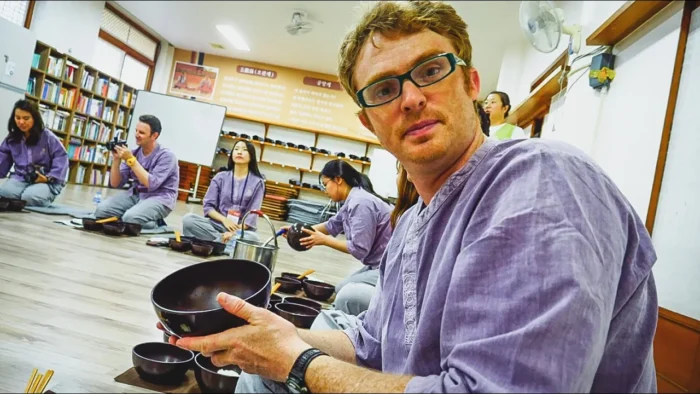
Busan During the Joseon Dynasty
During the Joseon Dynasty (1392-1897), Busan served as a crucial port for foreign trade and military defense. Its proximity to Japan made it a key point for interactions and sometimes conflicts. The city’s role as a gateway to the Korean Peninsula was firmly established during this period.
- Trade Hub: Facilitated commerce between Korea and neighboring countries.
- Military Significance: Served as a defensive stronghold against invasions.
- Cultural Exchange: Exposure to foreign influences shaped Busan’s unique cultural landscape.
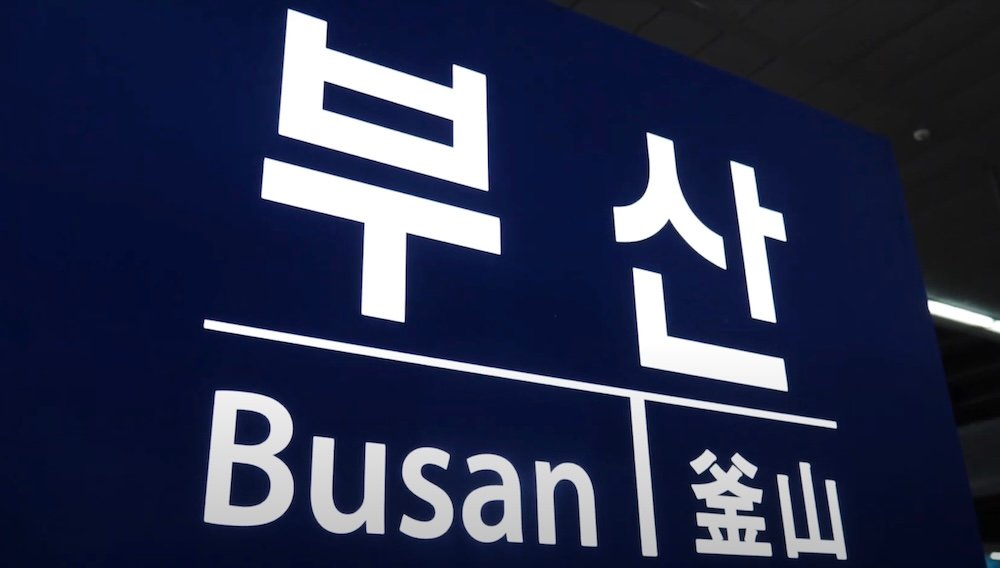
The Korean War and Busan’s Resilience
One of the most defining moments in Busan’s history occurred during the Korean War (1950-1953). As the North Korean forces advanced south, Busan became the last major stronghold for South Korean and United Nations troops. The city hosted a significant influx of refugees, transforming it into a temporary capital and a symbol of resilience and hope.
- Refugee Influx: Over a million people sought safety in Busan, leading to rapid urban growth.
- Strategic Defense: Played a pivotal role in preventing the fall of South Korea.
- Reconstruction Efforts: Post-war rebuilding efforts laid the foundation for modern Busan.

Post-War Development and Modernization
In the decades following the Korean War, Busan underwent remarkable transformation. The city’s economy surged, driven by its port activities, manufacturing industries, and international trade. Investments in infrastructure, including highways, bridges, and modern buildings, propelled Busan into the ranks of South Korea’s leading cities.
- Economic Growth: Became one of the world’s busiest ports, boosting trade and industry.
- Urban Expansion: Rapid development led to the creation of bustling districts and modern amenities.
- Cultural Flourishing: Emerged as a cultural hub with theaters, museums, and festivals.
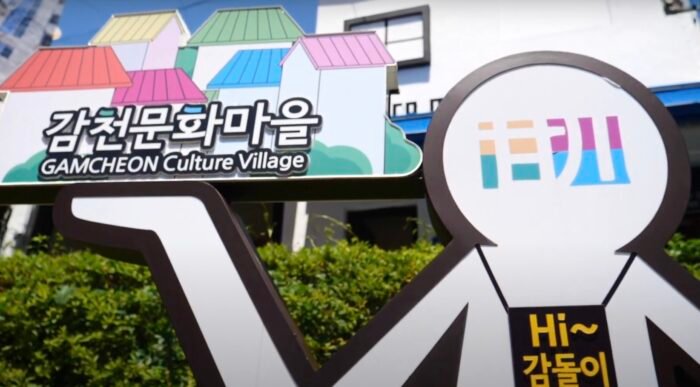
Busan in the 21st Century
Today, Busan stands as a dynamic metropolis, renowned for its beautiful beaches, cultural festivals, and innovative architecture. The city continues to honor its historical legacy while embracing modernity and innovation. Events like the Busan International Film Festival (BIFF) highlight Busan’s ongoing commitment to cultural excellence and global engagement.
- Cultural Events: Hosts international festivals that attract visitors worldwide.
- Modern Architecture: Iconic structures like the Busan Cinema Center showcase contemporary design.
- Sustainable Growth: Focuses on balancing economic development with environmental preservation.

Preserving Heritage Amidst Progress
Despite its rapid modernization, Busan remains dedicated to preserving its historical sites and cultural traditions. Areas like Gamcheon Culture Village and Beomeosa Temple offer glimpses into the city’s past, providing a contrast to the urban landscape. This blend of old and new ensures that Busan’s unique identity continues to thrive.
- Historical Preservation: Maintains ancient temples, forts, and traditional neighborhoods.
- Cultural Integration: Seamlessly combines modern attractions with historical landmarks.
- Community Engagement: Involves local communities in preserving and promoting Busan’s heritage.

Busan Top Attractions and Best Places to Visit in Korea
The second largest city in Korea and the point to where allied forces were driven back in the early, trying days of the Korean War, Busan is this nation’s metropolis by the sea. It boasts a much milder climate than its big brother, often staying well above freezing for a daytime high in the winter; as such, hardy species of palm trees and able to survive and grow here, giving the numerous beach areas a lofty appeal with native Koreans, who flock here in droves in the middle of the hot, humid summer months.
Also boosting this cities’ appeal is its world-famous international film festival, which has spurned a creative renaissance among the creative portion of the population in recent years.
Whether you are visiting to escape the cruel bite of winter that northern and inland sections suffer if you’re here as an expat, or if you just a tourist here to experience everything worthwhile that Korea has to offer, Busan should occupy a prime position on your “to-visit” list!
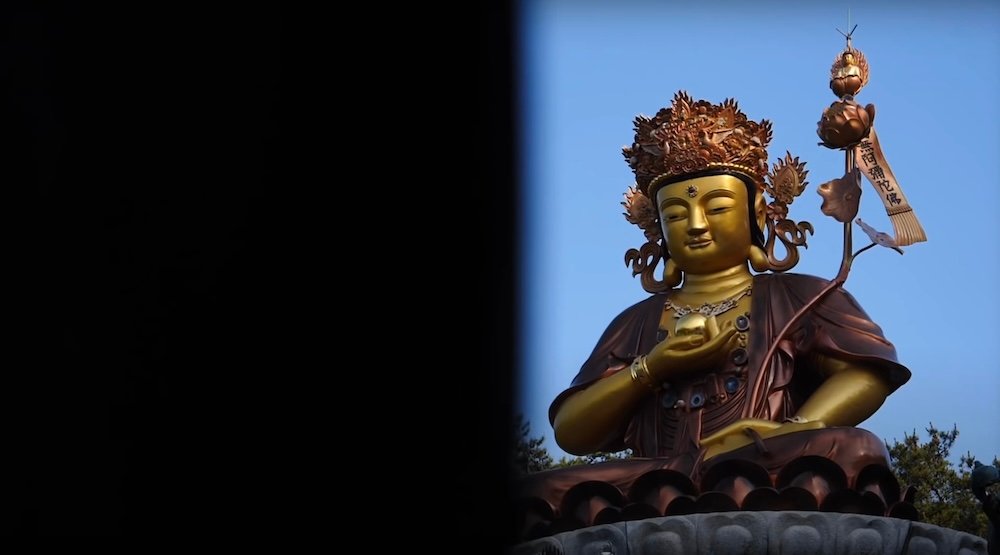
There are two Buddhist temples that you simply must see during your visit to Busan. The first one is called Beomeosa Temple, located up in the mountains towering above downtown. First constructed way back in 678 and rebuilt numerous times following invasions by foreign forces, Beomeosa Temple is a sanctuary of peace sitting well above the harried pace of life that flows on beneath these hallowed grounds.
Homestays are available for those that wish to live the lifestyle of a monk for a short period of time, which includes meals that are in line with their religious practice. For a breathtaking experience, visit during the fall months, when the hillsides are ablaze in vivid reds, ornages, and yellows, adding to the appeal of the traditional Korean architecture found here.

More Attractions
Next, take the 181 bus outside of Haeundae subway station and ride it to its terminus at Yonggungsa Temple, an unforgettable place of Buddhist worship situated on the jagged limestone coast east of Busan. Here, many photographic opportunities open up to avid photographers, as mist will frequently roll off the sea in varying patterns, making for tonnes of potential prize-winning shots.
Aside from the spectacular views is a spring where people attempt to toss won coins into a tiny area of the pool, in an attempt to gain some luck in their lives, and a gorgeous statue of Kwang Yin.
Those wishing to pay their respects to the brave men and women of the multinational UN-backed fighting force that dug in at Busan, and held back the surging tide of the North Korean army can do so at the UN Memorial Cemetery. Before heading out to this sombre place (reached by taking the Busan Subway to Kyungsung University Stn), ensure that you are wearing long pants, shirts with sleeves and close-toed shoes, or guards will deny you entry at the gate.
Finally, film buffs looking to enjoy the finest in Korean and world cinema should time their visit to Busan for the first ten days of October, as this is when the Busan International Film Festival is held every year. This festival has become insanely popular among Koreans, so be sure to plan ahead, get your tickets early, and arrive to your show early, lest you get stuck at the end of a line that wraps around the block!

Other Cultural Attractions: Trip to Busan, South Korea
Busan has many modern attractions well worth seeing. Let’s start this day of touring by heading to Nampo-dong and paying 5,000 won to go up Busan Tower. Not only go you get a sweeping view of this inspiring harbour city, your ticket also comes with an admission to a museum featuring musical instruments around the world. Quite the random pairing, but also an interesting collection to peruse over in its own right.
After snapping panorama photos to your heart’s content, amble down to the waterfront, where the smell of seafood should herald your arrival to the Jagalchi Fish Market. In this expansive wet market, the fishers of the sea have brought every conceivable life form that is edible, from shellfish to groundfish to that famously fatal (rarely, but it can happen!) fish known as fugu, known as bogeo in Korean.
If you wish to sample some of the aquatic life that you see on the ground floor on your dinner plate, enjoy one of the faster sea to stomach turnarounds on the third floor, where countless restaurateurs stand ready to feed your seafood habit.

Other Attractions
If on your way to the famous beaches of Busan you realize that you need a few essentials for the beach, like a bathing suit (darn, forgot it at home!), swing by Shinsegae Centum City, the largest department store on Earth. Try not to get distracted by the myriad of attractions vying for your attention, such as a skating rink and probably one of the best jjimjilbangs (Korean spa) in all of Busan, while you search for what you need to hit the sands further down the coast.
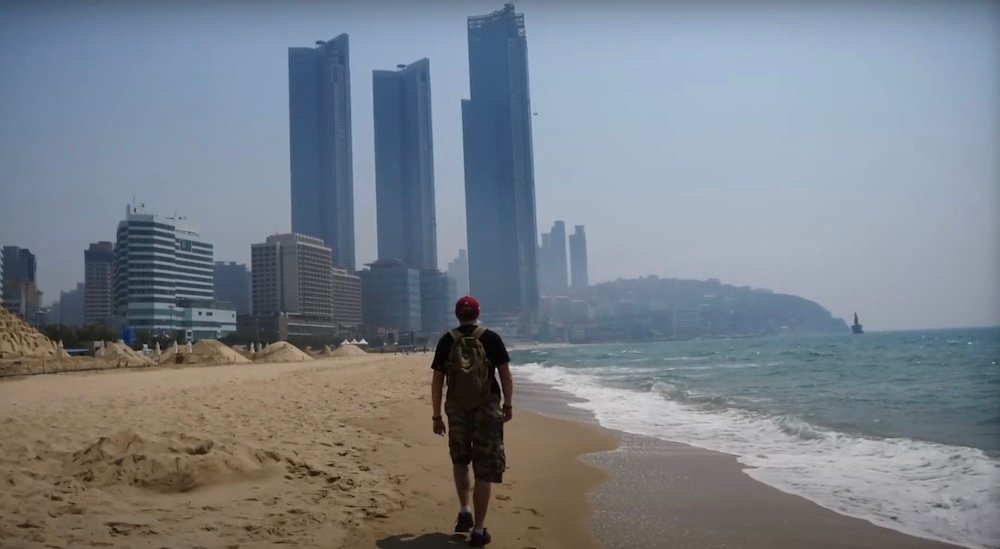
The beach in question, as alluded to in the previous paragraph is none other than Haeundae Beach, hands down the most popular beach in all of Korea. As a result, those searching for solitude may be sorely disappointed here, as the sands of this public treasure are hemmed in completely by loungers, and the masses that use them during the day. However, this portion of the city is also home to the best nightlife and foreign restaurants in the entire city, so if you’re looking to get your hair down in Busan, this is the place you’ll want to be.
Those looking to actually enjoy the beach without elbowing other people constantly will be better served at Seongjong Beach just east of the Busan city limits, and at Songdo Beach in Southwest Busan, as they have ample room to spread out and relax, without the hassle of getting lost in throngs of beachgoers.

Top 55 Things To Do in Busan, Korea For Visitors
Here are the top 55 things to do in Busan:

1. Visit Haeundae Beach
Haeundae Beach is famed for its soft white sands stretching over 1.5 kilometers and crystal-clear waters. It’s a popular spot for both locals and tourists, offering various water sports and beach activities. The beachfront is lined with cafes and restaurants where you can enjoy fresh seafood. During the summer, it hosts numerous festivals and events, making it the city’s most vibrant spot.
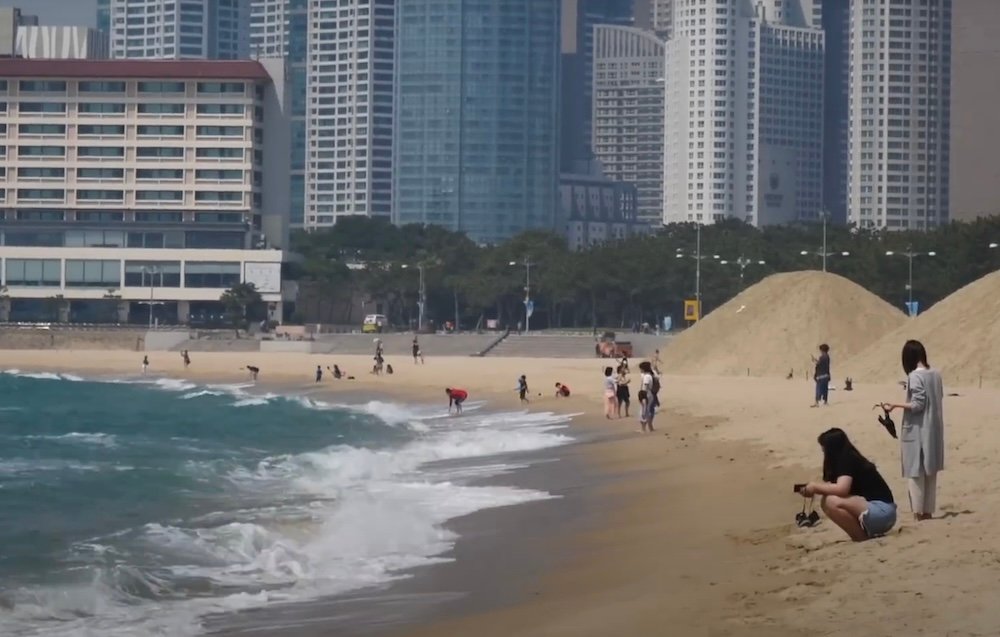
- Water Activities: Try jet skiing, parasailing, or paddleboarding.
- Culinary Delights: Savor fresh seafood at beachfront restaurants.
- Summer Festivals: Experience lively events like the Haeundae Sand Festival.

2. Explore Gamcheon Culture Village
Known as the “Machu Picchu of Busan,” Gamcheon Culture Village is a colorful hillside community. The narrow alleys are lined with brightly painted houses, cafes, and art installations. It’s a great place for photography and to experience the artistic side of Busan. The village’s history as a refuge for Korean War refugees adds depth to your visit.
- Artistic Murals: Capture the vibrant street art and murals.
- Local Cafes: Relax in charming cafes with stunning views.
- Cultural Exhibits: Discover unique art installations throughout the village.

3. Take a Trip to Taejongdae Resort Park
Taejongdae Resort Park offers stunning cliffside views of the sea, a dense pine forest, and a lighthouse that’s perfect for picturesque moments. You can take the Danubi Train to explore the park’s main attractions easily. The park is also known for its rock beach and offers a ferry ride for a closer look at the cliffs and sea. It’s a beautiful place to experience nature’s beauty in Busan.
- Danubi Train Ride: Conveniently tour the park’s key spots.
- Rock Beach Exploration: Walk along the unique rocky coastline.
- Ferry Rides: Get up close with the dramatic sea cliffs.

4. Shop at Jagalchi Fish Market
Jagalchi Fish Market, Korea’s largest seafood market, offers a glimpse into the local way of life and Busan’s maritime culture. Visitors can explore the indoor and outdoor sections to see a wide variety of fresh seafood. It’s an ideal place to experience Korea’s unique dining culture by having seafood prepared right after you pick it. The lively atmosphere and ocean backdrop make for an unforgettable experience.

- Fresh Seafood Selection: Choose from a vast array of marine offerings.
- Local Dining: Enjoy freshly prepared seafood at market eateries.
- Cultural Experience: Immerse yourself in Busan’s fishing traditions.
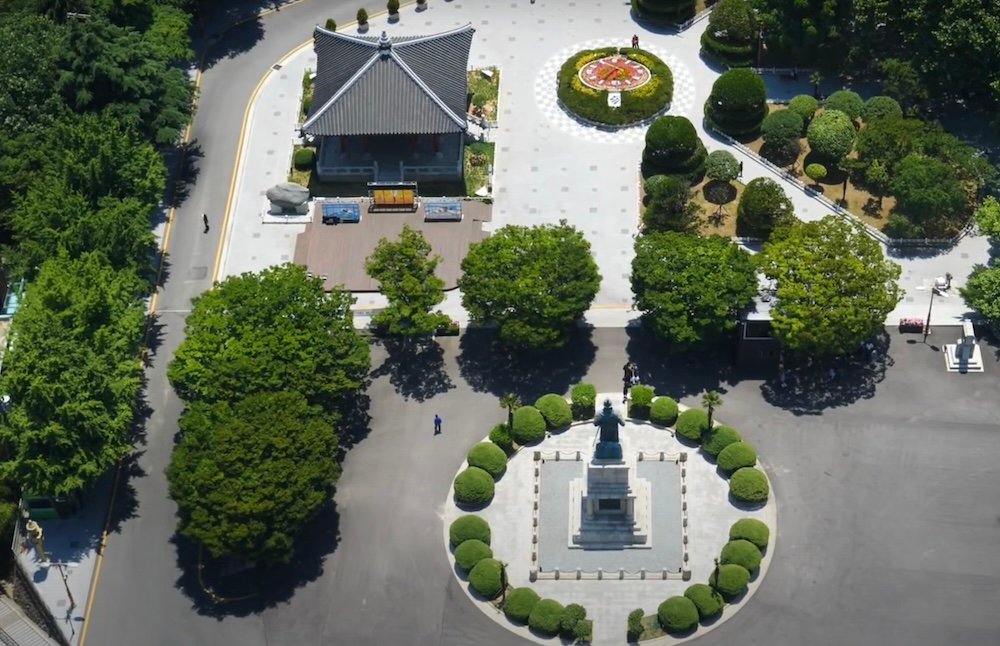
5. Stroll Through Yongdusan Park
Yongdusan Park, one of Busan’s most beloved green spaces, is home to the Busan Tower, offering panoramic views of the city. The park is beautifully landscaped and features monuments, including the Korean War Memorial. It’s a peaceful retreat in the heart of the city and hosts various cultural events throughout the year. The park’s name, meaning “Dragon Head Mountain,” is inspired by its shape resembling a dragon’s head.
- Busan Tower: Enjoy 360-degree views from the observation deck.
- Monuments and Memorials: Visit historical landmarks within the park.
- Cultural Events: Attend festivals and performances held annually.
6. Ascend Busan Tower
Busan Tower, standing at 120 meters tall in Yongdusan Park, provides breathtaking 360-degree views of Busan. The tower’s observation deck is a popular spot for visitors looking to capture the city’s skyline and harbor. At night, the tower lights up, making for a beautiful sight against the city backdrop. The tower also features a cafe and a gift shop for souvenirs.
- Observation Deck: Take in expansive views of Busan from above.
- Night Illumination: Witness the tower beautifully lit after dark.
- Souvenir Shopping: Purchase unique gifts at the tower’s gift shop.
7. Discover the Sea Life Busan Aquarium
Located in Haeundae Beach, the Sea Life Busan Aquarium is an underwater adventure featuring thousands of marine species. The aquarium includes a walk-through tunnel that offers an immersive experience of being surrounded by sea life. It’s an educational and entertaining visit for families, with various interactive exhibits. The aquarium’s efforts in marine conservation and education are also highlighted through its programs.
- Walk-Through Tunnel: Experience being underwater among marine creatures.
- Interactive Exhibits: Engage with hands-on displays and educational programs.
- Conservation Efforts: Learn about marine conservation initiatives.
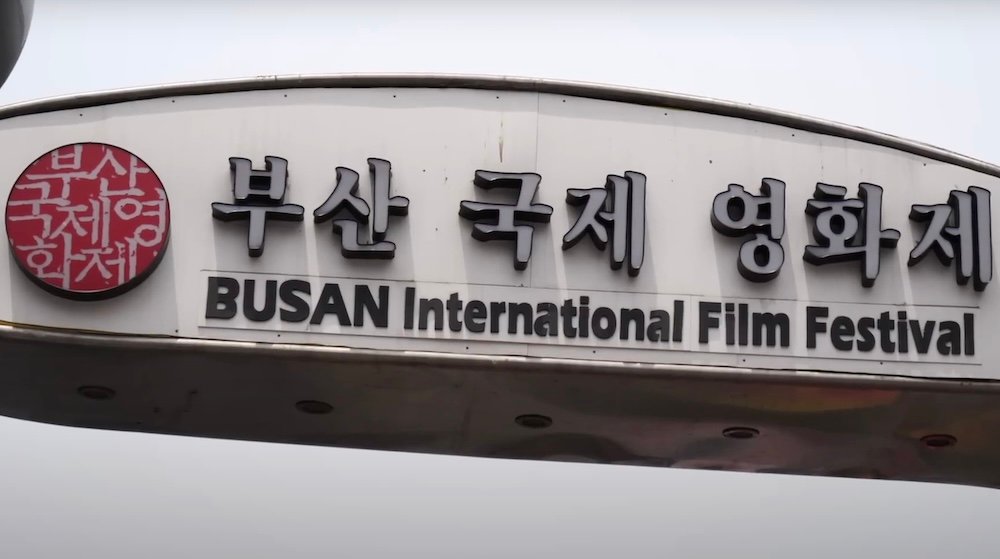
8. Experience the Busan International Film Festival (BIFF)
The Busan International Film Festival, held annually in the Haeundae district, is one of Asia’s most significant film festivals. It showcases a wide range of films from around the world, including many premieres. The festival includes screenings, discussions, and events that celebrate the art of filmmaking. It’s a must-attend for cinema enthusiasts and offers a chance to see emerging trends in the global film industry.
- International Films: Watch diverse films from various countries.
- Filmmaker Interactions: Participate in discussions with directors and actors.
- Exclusive Premieres: Be among the first to see new movie releases.
9. Relax at Gwangalli Beach
Gwangalli Beach is known for its fine sand, relaxed atmosphere, and the stunning view of the Gwangan Bridge, especially beautiful at night when illuminated. It’s a popular spot for water sports and has a lively beachfront area with cafes, bars, and restaurants. The beach hosts various events and music festivals, making it a cultural hub in Busan. It’s a great place to enjoy the urban beach life and nightlife.
- Water Sports: Engage in activities like windsurfing and kayaking.
- Nightlife: Enjoy vibrant bars and beachfront restaurants after dark.
- Scenic Views: Capture the illuminated Gwangan Bridge from the shore.

10. Walk Across Gwangan Bridge
Gwangan Bridge, spanning over Gwangalli Beach, is an architectural marvel and one of Busan’s most iconic landmarks. The bridge lights up at night in a dazzling display of colors, creating a mesmerizing view from the beach. It’s a popular spot for photographers and couples enjoying the romantic scenery. Though walking across the bridge itself isn’t possible, the view from the beach or nearby hills is spectacular.
- Nighttime Illumination: Witness the bridge’s stunning light show.
- Photography Hotspot: Capture memorable photos of the bridge and skyline.
- Romantic Views: Enjoy a picturesque setting for a date or evening stroll.

11. Visit Beomeosa Temple
Beomeosa Temple, located on the slopes of Geumjeongsan Mountain, is a significant Buddhist temple with a history dating back to 678 AD. The temple’s serene atmosphere is enhanced by its beautiful architecture and the surrounding ancient forest. It hosts temple stay programs for those interested in learning about Korean Buddhism and meditation. The temple’s intricate details and peaceful mountain backdrop make it a spiritual retreat from the city.
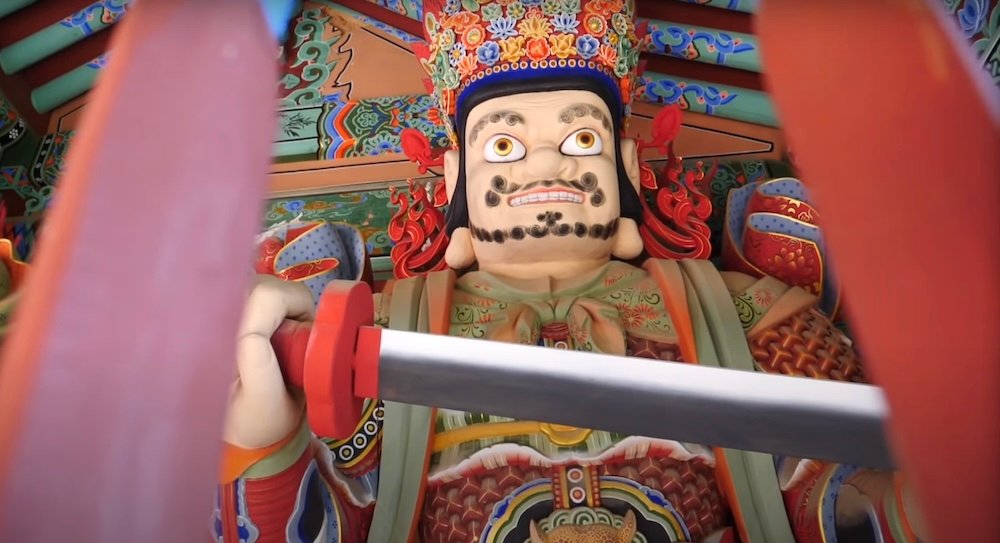
- Temple Stay Programs: Experience traditional Buddhist practices and meditation.
- Architectural Beauty: Admire the intricate design of the temple buildings.
- Nature Walks: Explore the ancient forest surrounding the temple grounds.

12. Hike Geumjeongsan Mountain
Geumjeongsan Mountain offers the best hiking trails in Busan, featuring stunning views, historic fortress walls, and lush landscapes. The mountain is home to Beomeosa Temple, adding a cultural aspect to your hike. There are routes for all levels of hikers, from easy walks to challenging treks. The panoramic views of Busan from the summit are truly rewarding.
- Diverse Trails: Choose from various paths catering to different fitness levels.
- Historical Sites: Explore ancient fortress walls along the hiking routes.
- Scenic Summits: Enjoy breathtaking views of Busan from the mountain’s peak.
13. Explore the UN Memorial Cemetery
The UN Memorial Cemetery honors UN soldiers from 16 countries that were killed during the Korean War. It’s a peaceful and beautifully maintained space that offers insight into the impact of the war on Korea and the world. The cemetery includes memorials, sculptures, and informative displays. It’s a place of reflection and historical significance.
- Memorial Structures: Visit various monuments dedicated to fallen soldiers.
- Educational Displays: Learn about the history and significance of the Korean War.
- Tranquil Environment: Reflect in the serene and respectful surroundings.
14. Enjoy Spa Land Centum City
Spa Land Centum City, located within the Shinsegae Centum City Department Store, offers a luxurious spa experience with various saunas, baths, and relaxation zones. It’s known for its modern facilities, including a salt room, ice room, and outdoor foot baths. Spa Land provides a high-end introduction to Korea’s jjimjilbang (public bathhouse) culture. It’s a perfect place to unwind after a day of exploring Busan.
- Diverse Spa Facilities: Experience different types of saunas and baths.
- Relaxation Zones: Enjoy quiet areas for rest and rejuvenation.
- Cultural Experience: Immerse yourself in traditional Korean spa practices.
15. Visit the National Maritime Museum
The National Maritime Museum is one of Korea’s largest museums, dedicated to the country’s maritime history and culture. The museum features interactive exhibits, historic ships, and maritime artifacts. It’s an educational visit for all ages, offering insights into Korea’s relationship with the sea. The museum’s architecture, resembling a ship, is also noteworthy.
- Historic Ships: Explore replica and actual vessels used throughout history.
- Interactive Displays: Engage with hands-on exhibits about maritime life.
- Architectural Design: Admire the museum’s ship-like structure and design elements.
16. Take a Day Trip to Oryukdo Skywalk
The Oryukdo Skywalk offers thrilling views over the cliffs and the sea from a glass-bottomed platform. Located on the edge of Oryukdo Island, the skywalk is a popular attraction for those seeking spectacular coastal views. The area around Oryukdo is known for its natural beauty and walking trails. It’s an excellent spot for photography and experiencing the power of the ocean.
- Glass-Bottom Platform: Experience the thrill of walking over transparent glass.
- Scenic Trails: Enjoy hiking paths with stunning seaside vistas.
- Photography Opportunities: Capture dramatic views of the ocean and cliffs.
17. Shop at Shinsegae Centum City
Shinsegae Centum City is recognized by the Guinness World Records as the world’s largest department store. It features a wide range of shopping options, from high-end brands to Korean fashion, and includes a spa, ice rink, and cinema. The food court offers a variety of international and Korean cuisine. It’s a shopper’s paradise and a great place to experience the modern luxury side of Busan.
- Extensive Retail Selection: Browse through countless stores and brands.
- Entertainment Facilities: Enjoy ice skating, movies, and spa treatments.
- Culinary Variety: Taste diverse foods from the expansive food court.
18. Discover the Trickeye Museum Busan
The Trickeye Museum Busan is an interactive art museum that features optical illusion paintings and installations that come to life through augmented reality. It’s a fun experience for families and groups of friends, offering countless photo opportunities. The museum encourages visitors to become part of the art in creative and amusing ways. It’s a break from traditional museums and a dive into imaginative play.
- Optical Illusions: Pose with art that creates stunning visual effects.
- Augmented Reality: Interact with digital elements enhancing the exhibits.
- Creative Photo Ops: Capture unique and playful images with friends and family.
19. Relax at Songdo Beach
Songdo Beach, known for its scenic cable car offering views of the coastline and city, is a historic beach in Busan. It’s less crowded than Haeundae and Gwangalli, providing a more relaxed atmosphere. The beach is great for swimming, jet skiing, and banana boating. The Songdo Cloud Trails, extending over the sea, make for a beautiful walk.
- Cable Car Rides: Enjoy panoramic views from above the beach.
- Water Sports: Engage in fun activities like jet skiing and banana boating.
- Cloud Trails Walk: Stroll along the elevated pathways for scenic vistas.
20. Cross the Songdo Skywalk
The Songdo Skywalk extends over the ocean, providing stunning views of Songdo Beach and its surroundings. The glass-bottomed path adds an element of thrill to the scenic walk. At night, the skywalk is illuminated, creating a romantic atmosphere. It’s a relatively new attraction that has quickly become a favorite for both locals and tourists.
- Glass Pathway: Experience the excitement of walking above the water.
- Nighttime Lights: Enjoy the skywalk’s beautiful illumination after dark.
- Scenic Views: Take in the expansive ocean and cityscape from above.
21. Attend the Busan International Rock Festival
The Busan International Rock Festival showcases rock bands from Korea and around the world, set against the backdrop of Samnak Ecological Park. It’s one of Busan’s largest music festivals, attracting a diverse crowd of music fans. The festival offers a lively atmosphere with food stalls and merchandise vendors. It’s a must-attend for rock music enthusiasts visiting Busan in the summer.
- Live Performances: Enjoy concerts from both local and international rock bands.
- Festival Atmosphere: Immerse yourself in the vibrant and energetic environment.
- Food and Merchandise: Explore various food options and shop for band merchandise.

22. Explore Lotte Premium Outlet Dongbusan
Lotte Premium Outlet Dongbusan is a spacious outdoor shopping mall that offers a wide range of international and Korean brands at discounted prices. It’s located in a scenic area, making shopping a pleasant experience. The outlet includes a food court, children’s play area, and a multiplex cinema. It’s a great place for bargain hunters looking to enjoy a day of shopping.
- Discounted Brands: Find deals on both international and local brands.
- Family-Friendly Amenities: Enjoy facilities like play areas and cinemas.
- Scenic Shopping: Shop in a pleasant outdoor environment with beautiful surroundings.
23. Visit the Busan Museum of Art
The Busan Museum of Art focuses on contemporary art, featuring works by Korean and international artists. The museum’s exhibitions are thought-provoking and cover a wide range of media. It also hosts workshops, lectures, and cultural events. The museum’s serene atmosphere and modern architecture are perfect for art lovers.
- Contemporary Exhibits: Explore modern artworks and innovative installations.
- Interactive Workshops: Participate in art-making sessions and educational programs.
- Cultural Events: Attend lectures and special events hosted by the museum.
24. Wander Through Igidae Park
Igidae Park offers coastal walking paths with spectacular views of the ocean, Gwangan Bridge, and the city’s skyline. The park’s natural beauty is a photographer’s dream, especially during sunrise and sunset. It’s also a popular spot for bird watching and hiking. The park provides a quiet escape from the urban environment.
- Scenic Walks: Enjoy leisurely strolls along the picturesque coastal paths.
- Photography Opportunities: Capture stunning views of the ocean and cityscape.
- Wildlife Watching: Observe various bird species in their natural habitat.
25. Take in the Views from Hwangnyeongsan Mountain
Hwangnyeongsan Mountain, located in the heart of Busan, is an easily accessible spot known for its panoramic views of the city. You can drive or hike to the summit. The mountain is especially popular at night when the city lights create a stunning landscape. It’s a romantic spot and a favorite among locals and tourists for its breathtaking scenery.
- Summit Views: Enjoy expansive vistas of Busan from the top.
- Accessible Trails: Reach the summit easily by car or a short hike.
- Nighttime Beauty: Witness the city illuminated under the night sky.
26. Busan Cinema Center
The Busan Cinema Center is an architectural marvel and the official venue of the Busan International Film Festival. Its expansive outdoor roof, known as the Big Roof, is illuminated with thousands of LED lights, creating a mesmerizing display. Inside, visitors can explore the history of cinema and attend screenings and cultural events. The center is a must-visit for film enthusiasts and architecture lovers.
- Big Roof Light Show: Marvel at the stunning LED light displays on the outdoor roof.
- Cinema Exhibits: Learn about the evolution of film through interactive displays.
- Cultural Events: Participate in film screenings, workshops, and festivals.
27. Gukje Market
Gukje Market is one of Busan’s largest markets, offering a vast array of goods, from clothes and accessories to electronics and household items. The market’s bustling lanes also feature a variety of street food stalls serving local delicacies. It’s a great place to experience the local culture and practice your bargaining skills. The market’s history, tied to the Korean War and refugees, adds a historical dimension to your visit.
- Diverse Shopping: Browse through countless shops offering a wide range of products.
- Street Food: Taste traditional Korean snacks and dishes from various vendors.
- Cultural Experience: Immerse yourself in the vibrant atmosphere and rich history of the market.
28. Haedong Yonggungsa Temple
Haedong Yonggungsa Temple, situated along the coast, is unique among Korean temples because of its stunning ocean view. The temple complex includes a series of bridges, halls, and statues that are especially beautiful during sunrise. It’s known for its peaceful atmosphere and scenic beauty. Visitors come here to make wishes and enjoy the panoramic views of the sea.
- Oceanfront Location: Experience the serene beauty of a temple by the sea.
- Architectural Features: Explore intricate bridges and traditional halls.
- Sunrise Views: Witness breathtaking sunrises over the ocean from the temple grounds.
29. Bosu-dong Book Street
Bosu-dong Book Street is a charming alley lined with second-hand bookstores and cafes. It’s a haven for book lovers, offering a wide range of books, from vintage and rare editions to contemporary novels. The street’s quaint atmosphere is perfect for leisurely browsing and sipping coffee. It’s also a great place to find unique souvenirs and gifts.
- Second-Hand Bookstores: Discover rare and vintage books at affordable prices.
- Cozy Cafes: Relax with a cup of coffee in a warm, inviting setting.
- Unique Shopping: Find one-of-a-kind souvenirs and literary gifts.
30. Oryukdo Islands
The Oryukdo Islands are a group of small islets off the southern coast of Busan, offering stunning natural landscapes and sea views. A skywalk overlooking the islands provides a thrilling experience with its glass-bottomed platform. The area is great for hiking and photography, with several viewpoints along the coast. The name Oryukdo, meaning “five-six islands,” reflects the changing number of islands visible depending on the tide.
- Skywalk Adventure: Walk on transparent glass for an exhilarating view.
- Hiking Trails: Explore scenic paths with breathtaking coastal views.
- Photography Spots: Capture the dynamic beauty of the islands and ocean.
31. Busan Tower in Yongdusan Park
Busan Tower, nestled within Yongdusan Park, offers panoramic views of the city from its observation deck. This prominent landmark is a favorite among visitors looking to see Busan from above. At night, the tower is illuminated, creating a stunning sight against the city’s skyline. The surrounding park is a peaceful retreat adorned with monuments and sculptures.
- Observation Deck: Enjoy expansive views of Busan’s skyline and harbor.
- Night Illumination: Witness the tower beautifully lit up after dark.
- Park Surroundings: Explore the serene park filled with historical monuments.
32. Choryang Ibagu-gil Road
Choryang Ibagu-gil Road is a cultural and historical walking path that narrates the story of Choryang’s past and present through murals and installations. The trail offers stunning views of Busan Harbor and includes stops at historical sites and local eateries. It’s a unique way to explore the city’s history while enjoying delicious local flavors. The walk is both educational and entertaining, making it suitable for all ages.
- Artistic Murals: Discover colorful murals that depict the area’s rich history.
- Harbor Views: Take in breathtaking sights of Busan Harbor along the path.
- Local Eats: Sample tasty dishes from nearby eateries during your stroll.
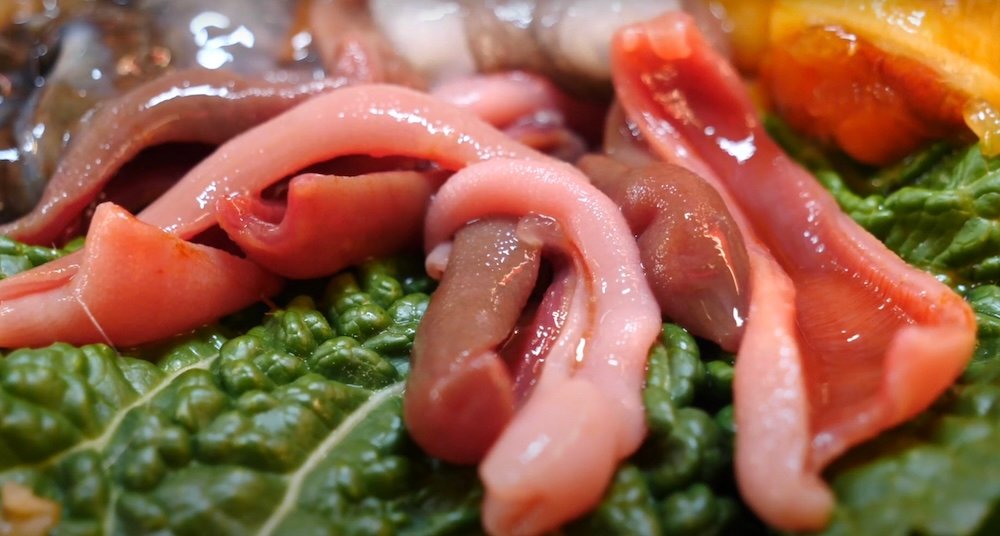
33. Bujeon Market
Bujeon Market is renowned for its fresh produce, seafood, and Korean delicacies. As one of the busiest markets in Busan, it offers an authentic shopping experience. Visitors can find a variety of local ingredients and indulge in street food favorites. The lively atmosphere and the chance to interact with local vendors make it a memorable visit.
- Fresh Produce: Shop for a wide selection of fruits, vegetables, and seafood.
- Street Food: Taste traditional Korean snacks and meals from various stalls.
- Local Interaction: Engage with friendly vendors and learn about local products.
34. Nurimaru APEC House
Nurimaru APEC House, located on Dongbaekseom Island, served as the venue for the APEC summit meeting. The architecture blends modern and traditional Korean styles, offering beautiful views of the sea and Haeundae Beach. Now a public exhibition space and conference center, it hosts various cultural and historical exhibits. The surrounding area, with its scenic walking paths and coastal views, is also worth exploring.
- Architectural Beauty: Admire the harmonious blend of modern and traditional designs.
- Exhibition Space: Visit exhibits showcasing cultural and historical themes.
- Scenic Walks: Enjoy leisurely strolls along the picturesque coastal paths.
35. Songjeong Beach
Songjeong Beach is known for its relaxed atmosphere and clear waters, making it a favorite spot for families and surfers. Unlike Haeundae, it’s less crowded, offering a more laid-back vibe. Surfing schools and rental shops along the beach provide lessons and equipment for visitors. The annual Songjeong Beach Festival celebrates the local surfing culture and community.
- Surfing Opportunities: Learn to surf or rent equipment for a day on the waves.
- Family-Friendly: Enjoy safe swimming areas and beach activities for all ages.
- Beach Festivals: Participate in lively events celebrating surfing and local culture.
36. Dongnae Eupseong Fortress
Dongnae Eupseong Fortress is a historical site that played a crucial role in defending Busan during various invasions. Visitors can explore the remains of the fortress walls and learn about its history through exhibitions. The surrounding area is known for its hot springs, adding another reason to visit. The site is a blend of history, culture, and relaxation.
- Fortress Remains: Walk along the ancient walls and explore historical structures.
- Educational Exhibits: Gain insights into the fortress’s strategic importance.
- Hot Springs Nearby: Relax in natural hot springs after exploring the site.
37. Jangsan Mountain
Jangsan Mountain is a popular hiking destination offering trails with varying levels of difficulty and stunning views of the city and sea. The mountain is especially beautiful in spring when the azaleas bloom. It’s a great place for outdoor enthusiasts looking to escape the urban environment. The peak provides a panoramic view that is simply breathtaking.
- Seasonal Blooms: Enjoy vibrant azaleas and other seasonal flowers.
- Diverse Trails: Choose from easy paths to more challenging hikes.
- Scenic Summits: Take in expansive views of Busan and the surrounding sea.
38. Huinnyeoul Culture Village
Huinnyeoul Culture Village, situated on the cliffs overlooking the sea, is known for its narrow alleys, white houses, and artistic vibe. The village has become a hub for artists and creatives, with galleries, workshops, and cafes. It’s a picturesque place for a leisurely walk, offering beautiful views and a peaceful atmosphere. The village’s transformation from a neglected area to a cultural hotspot is inspiring.
- Art Galleries: Explore works from local and international artists.
- Creative Workshops: Participate in art-making sessions and creative classes.
- Scenic Walks: Enjoy the stunning coastal views and charming architecture.
39. Centum City
Centum City, home to the world’s largest department store, Shinsegae Centum City, is a modern shopping and entertainment complex. It features a wide range of shops, an ice rink, a spa, and a cinema. The area is a testament to Busan’s development and is a shopper’s paradise. It’s also home to the Busan Cinema Center, adding to the area’s attractions.
- Extensive Shopping: Browse through numerous stores offering diverse products.
- Entertainment Options: Enjoy activities like ice skating, spa treatments, and movie screenings.
- Cultural Venues: Visit the Busan Cinema Center for film-related events and exhibitions.

40. Busan Gamcheon Culture & Fish Market
This combined cultural and fish market in the Gamcheon area offers a unique blend of art, history, and local seafood. Visitors can enjoy fresh fish and traditional Korean dishes while exploring the colorful streets of Gamcheon Culture Village. The market is a great place to experience the local lifestyle and cuisine. It embodies the spirit of Busan, where tradition and modernity coexist.
- Seafood Delicacies: Taste fresh and authentic Korean seafood dishes.
- Cultural Exploration: Discover the artistic elements integrated into the market.
- Local Lifestyle: Observe and engage with the daily lives of Busan residents.
41. Taejongdae Clam Tents
The clam tents at Taejongdae offer a unique dining experience where visitors can enjoy fresh seafood, particularly clams, cooked right at their table. The area is known for its scenic beauty, making it a perfect spot for a meal with a view. It’s a popular destination for both locals and tourists looking to enjoy Busan’s maritime culture. The relaxed, informal setting provides a glimpse into the local way of life.
- Fresh Seafood Dining: Savor clams and other seafood prepared to your liking.
- Scenic Views: Enjoy meals with stunning ocean and cliffside backdrops.
- Casual Atmosphere: Relax in an informal setting that reflects local dining culture.
42. United Nations Memorial Cemetery
This cemetery honors the UN soldiers from 22 countries who died during the Korean War. It’s a peaceful, beautifully landscaped area that offers a space for reflection on the cost of war and the value of peace. The cemetery includes several memorials and sculptures that enhance its solemn beauty. It’s the only UN cemetery in the world, making it a unique and meaningful visit.
- Memorial Structures: Pay respects at various monuments dedicated to fallen soldiers.
- Serene Environment: Reflect in the tranquil and respectful surroundings.
- Historical Significance: Learn about the role of UN forces in the Korean War.
43. F1963
F1963 is a cultural complex converted from an old wire factory, showcasing Busan’s innovative approach to urban regeneration. It features art galleries, shops, cafes, and a popular concert hall. The space retains much of its industrial charm, blended with contemporary design. It’s a great example of how industrial spaces can be transformed into vibrant cultural hubs.
- Art Galleries: Explore contemporary art exhibitions in a unique setting.
- Live Performances: Attend concerts and cultural events at the concert hall.
- Industrial-Chic Ambiance: Enjoy the blend of old factory elements with modern aesthetics.
44. Amnam Park
Amnam Park, located on the western edge of Busan, offers stunning coastal views, rock formations, and hiking trails. The park is less frequented by tourists, providing a quiet retreat. It’s an excellent place for photography, picnics, and nature walks. The park’s natural beauty and tranquility make it a hidden gem in Busan.
- Coastal Scenery: Enjoy breathtaking views of the ocean and surrounding landscapes.
- Hiking Trails: Explore paths that wind through diverse natural settings.
- Picnic Areas: Relax and dine in designated picnic spots amidst nature.
45. Gwangbokro Culture and Fashion Street
This bustling street in the heart of Busan is a paradise for shoppers and foodies, offering a wide range of fashion boutiques, street food stalls, and restaurants. The area is also known for its cultural performances and street art. It’s a great place to experience the lively urban culture of Busan. The street’s vibrant atmosphere reflects the city’s youthful spirit.
- Fashion Boutiques: Shop for the latest trends and unique fashion pieces.
- Street Food: Taste a variety of delicious Korean street snacks and meals.
- Cultural Events: Enjoy live performances and observe vibrant street art.
46. Busan Museum
The Busan Museum provides an in-depth look at the city’s history and culture through its extensive exhibits. It covers various periods, from ancient times to the modern era, highlighting Busan’s role in Korean history. The museum also features an outdoor garden with sculptures and historical artifacts. It’s an educational visit that offers insights into the region’s heritage.
- Historical Exhibits: Learn about Busan’s evolution through detailed displays.
- Outdoor Garden: Stroll through gardens adorned with sculptures and artifacts.
- Educational Programs: Participate in guided tours and interactive learning sessions.
47. Busan Modern History Museum
Located in a historic building, the Busan Modern History Museum explores the city’s development during the 19th and 20th centuries. It highlights Busan’s significance in Korea’s modernization and its interactions with foreign countries. The museum includes exhibits on the Korean War and Busan’s role as a temporary capital. It’s a fascinating place for those interested in modern history and international relations.
- Modern History Exhibits: Discover Busan’s transformation through recent centuries.
- War Exhibits: Learn about the city’s strategic role during the Korean War.
- Historic Building: Appreciate the architecture of the museum’s original structure.

48. Sajik Baseball Stadium
For sports enthusiasts, attending a baseball game at Sajik Stadium offers a chance to experience Korea’s passionate baseball culture. The stadium is home to the Lotte Giants, and games here are known for their lively atmosphere. Fans singing, chanting, and enjoying the game create an unforgettable experience. It’s a fun way to spend an evening and mingle with locals.

- Live Baseball Games: Cheer for the Lotte Giants in an energetic setting.
- Fan Activities: Participate in chants and enjoy the communal spirit.
- Stadium Facilities: Enjoy snacks and merchandise available at the venue.

49. Songdo Cloud Trails
Songdo Cloud Trails is an impressive skywalk that extends over the sea, providing stunning views of Songdo Beach and its surroundings. The trail includes glass sections that give the sensation of walking over the water. It’s an excellent spot for a scenic walk, especially during sunset. The Cloud Trails are a modern addition to Busan’s attractions, offering a unique perspective of the coast.
- Glass Walkway: Experience the thrill of walking on transparent sections above the sea.
- Sunset Views: Capture breathtaking sunsets from the elevated trail.
- Scenic Strolls: Enjoy leisurely walks with panoramic coastal vistas.

50. Lotte Giants Game
Experiencing a Lotte Giants game at Sajik Baseball Stadium is a must-do for sports fans visiting Busan. The energetic crowd, cheering routines, and fast-paced action make for an exciting outing. Baseball is one of Korea’s most popular sports, and attending a game is a great way to engage with local culture. The stadium’s atmosphere is electric, especially during key matches.
- Live Sports Action: Watch the Lotte Giants compete in thrilling baseball games.
- Fan Engagement: Join in the chants and cheers with passionate fans.
- Stadium Experience: Enjoy the vibrant energy and lively environment of the game.
51. Cheongsapo Daritdol Observatory
The Cheongsapo Daritdol Observatory is a relatively new attraction in Busan, offering panoramic views of the sea and surrounding coastline from its glass-floored skywalk. Located near Haeundae, it’s a thrilling experience for visitors seeking unique photo opportunities. The observatory is part of a scenic walkway that connects to various beaches and dining spots. It’s a great addition to any itinerary for those looking to explore Busan’s natural beauty.
- Glass-Floored Skywalk: Experience walking on transparent surfaces above the ocean.
- Panoramic Views: Enjoy sweeping vistas of the coastline and city.
- Photo Opportunities: Capture stunning and unique photographs from the observatory.
52. Gwanganlli Beach at Night
Gwanganlli Beach is renowned for its lively atmosphere and stunning night views of the illuminated Gwangan Bridge. At night, the area comes alive with street performers, food stalls, and outdoor cafes. It’s a popular gathering place for both locals and tourists to enjoy the evening sea breeze and vibrant city life. The bridge’s light show is a highlight, creating a magical backdrop for an evening out.
- Nighttime Entertainment: Enjoy live performances and bustling street activities.
- Food Stalls: Taste a variety of delicious Korean and international snacks.
- Light Shows: Witness the dazzling illumination of Gwangan Bridge after dark.
53. Haeundae Market
Adjacent to Haeundae Beach, Haeundae Market is a bustling spot where visitors can sample a variety of street food and local specialties. The market is known for its fresh seafood, Korean snacks, and vibrant atmosphere. It’s a great place to grab a bite after a day at the beach or to explore the local culinary scene. The market also offers souvenirs and traditional Korean items.
- Street Food Variety: Indulge in diverse and tasty Korean snacks.
- Fresh Seafood: Choose from an array of fresh catches available daily.
- Souvenir Shopping: Find unique gifts and traditional items to take home.
54. Busan Cinema Center
As the venue for the Busan International Film Festival, the Busan Cinema Center is an architectural masterpiece known for its vast roof and outdoor theater. The center hosts various film screenings, cultural events, and art exhibitions throughout the year. Its design and lighting make it one of the most iconic structures in Busan. Visiting the Cinema Center is a must for movie buffs and architecture enthusiasts alike.
- Architectural Design: Admire the modern and innovative structure of the center.
- Film Screenings: Attend a variety of movie showings and premieres.
- Cultural Events: Participate in art exhibitions and interactive cultural activities.
55. Millak Waterfront Park
Millak Waterfront Park, located along Gwanganlli Beach, offers open spaces for leisure activities, outdoor performances, and waterfront dining. It’s a great spot for an evening walk, with spectacular views of the Gwangan Bridge. The park is popular for picnics, exercising, and simply enjoying the sea view. The combination of urban and natural elements makes it a unique place to relax and enjoy Busan’s coastal charm.
- Leisure Activities: Engage in sports, picnics, and outdoor games.
- Waterfront Dining: Enjoy meals at restaurants with stunning beach views.
- Evening Walks: Stroll along the park’s paths while taking in the beautiful scenery.

What To Eat and Drink in Busan, South Korea
Let’s just straight up dive into some must-try foods and drinks that you shouldn’t miss during your visit to Busan.
1. Milmyeon (Wheat Noodles)
Milmyeon is a Busan specialty that’s perfect for cooling down on a hot day. These wheat-based noodles are served in a chilled broth, often garnished with slices of cucumber, boiled egg, and pickled radish. The dish is renowned for its light yet flavorful taste, making it a favorite among locals and tourists alike. Whether enjoyed at a bustling market or a cozy restaurant, Milmyeon offers a refreshing taste of Busan’s culinary ingenuity.
- Chilled Broth: Enjoy the cool, savory broth that perfectly complements the noodles.
- Fresh Toppings: Slices of cucumber, boiled egg, and pickled radish add texture and flavor.
- Local Favorites: Try it at famous spots like Milmyeon Alley in Nampo-dong.
2. Ssiat Hotteok (Seed-Stuffed Pancakes)
Ssiat Hotteok is a unique twist on the traditional Korean hotteok, filled with a delicious mix of seeds, nuts, and brown sugar. This sweet treat is crispy on the outside and gooey on the inside, offering a delightful contrast in every bite. Originating from Busan, these pancakes are a popular street food that you can find in bustling markets and vibrant neighborhoods. They’re perfect for a quick snack or a sweet ending to your meal.
- Nutty Filling: A hearty mixture of seeds and nuts provides a satisfying crunch.
- Sweet and Sticky: The brown sugar syrup adds a rich sweetness that caramelizes as it cooks.
- Street Food Staple: Available at places like Gukje Market and Bupyeong Kkangtong Market.
3. Eomuk (Fish Cake)
Eomuk, or Korean fish cake, is a beloved Busan snack that showcases the city’s deep connection to the sea. Made from ground fish mixed with starch and seasoning, Eomuk is often served on skewers or in a savory broth as part of a hot pot. The texture is chewy and satisfying, making it a comforting choice during cooler months. Don’t miss the chance to try various shapes and flavors as you explore Busan’s vibrant food streets.
- Variety of Shapes: From simple sticks to intricate designs, Eomuk comes in many forms.
- Savory Broth: Enjoy it hot in a flavorful broth, perfect for warming up.
- Market Finds: Best experienced at Jagalchi Fish Market, where freshness is guaranteed.
4. Dongnae Pajeon (Green Onion Pancake)
Dongnae Pajeon is a regional variation of the classic Korean green onion pancake, distinguished by its crispy exterior and soft, flavorful interior. Packed with fresh green onions and often enhanced with seafood like shrimp or squid, this savory pancake is a must-try when visiting Busan. It’s typically enjoyed with a side of makgeolli (rice wine), making it a perfect pairing for a relaxing evening.
- Crispy Texture: Achieve the perfect balance between crunchy edges and a tender center.
- Seafood Addition: Includes shrimp, squid, or other seafood for an extra burst of flavor.
- Local Delicacy: Find authentic Dongnae Pajeon at Dongnae Market and specialty restaurants.
5. Haeundae Ssiat Hotteok (Haeundae Seed Pancakes)
A variation of the traditional Ssiat Hotteok, Haeundae Ssiat Hotteok adds its own local flair with additional seasonal ingredients and unique flavor profiles. These pancakes are stuffed with a generous mix of seeds, nuts, and sweet fillings, making each bite a delightful experience. They are especially popular during the Busan International Film Festival (BIFF), where street vendors offer them as a tasty treat for festival-goers.
- Seasonal Ingredients: Incorporates fresh, local ingredients that vary with the seasons.
- Festival Favorite: Widely enjoyed during BIFF for a quick and delicious snack.
- Enhanced Flavors: Experiment with different fillings like honey, chocolate, or fruit preserves.
6. Raw Fish (Hoe)
For those who crave fresh and raw flavors, Busan offers an array of Hoe (sashimi) that highlights the city’s exceptional seafood quality. Served with a variety of dipping sauces, including the spicy gochujang and tangy soy-based options, raw fish is a delicacy that’s both light and satisfying. Whether you prefer salmon, tuna, or mackerel, Busan’s fish markets and upscale restaurants provide top-notch options that are sure to impress.
- Fresh Selection: Choose from the day’s freshest catches at markets like Jagalchi.
- Variety of Sauces: Enhance the flavor with traditional Korean dipping sauces.
- Premium Experience: Enjoy high-quality raw fish at renowned establishments such as The Bay 101.
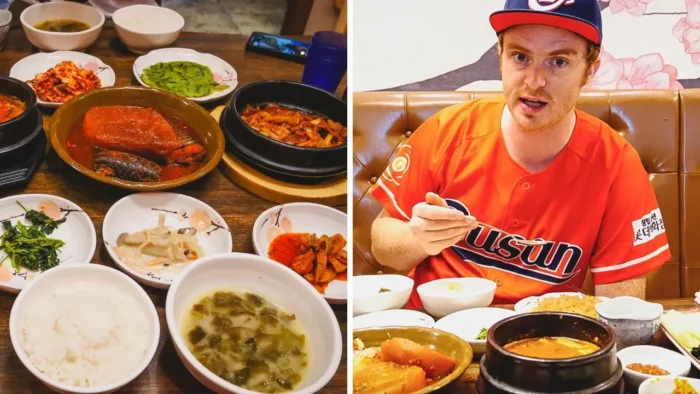
7. Gukbap (Soup with Rice)
Gukbap is a comforting dish that combines hearty soups with steaming bowls of rice, offering a warm and satisfying meal. In Busan, variations like Dwaeji Gukbap (pork soup with rice) are particularly popular, featuring tender pork slices, vegetables, and flavorful broths. It’s an ideal choice for breakfast or a late-night meal, providing both nourishment and warmth during your Busan adventures.
- Hearty Broths: Rich and flavorful soups that are both nourishing and delicious.
- Tender Pork: Enjoy succulent pork slices that melt in your mouth.
- Local Favorite: Sample authentic Gukbap at eateries like Gukje Market and Nampo-dong.
8. Makgeolli (Rice Wine)
No culinary journey in Busan is complete without trying makgeolli, a traditional Korean rice wine that perfectly complements the city’s savory dishes. This milky, slightly sweet alcoholic beverage is made from fermented rice and has a refreshing taste that pairs wonderfully with pancakes, grilled meats, and spicy dishes. Enjoy it in a casual setting, whether at a bustling market stall or a cozy, traditional Korean pub (pojangmacha).
- Traditional Brew: Experience the authentic taste of handcrafted makgeolli.
- Perfect Pairing: Enhances the flavors of savory dishes like pajeon and BBQ.
- Local Bars: Visit popular spots like Makgeolli Alley in Nampo-dong for the best selections.
9. Sundae (Korean Blood Sausage)
Busan’s take on sundae is a delicious and unique street food that shouldn’t be missed. Unlike the traditional sausage, Busan-style sundae is often made with various fillings such as glass noodles, vegetables, and seasoned pork, all wrapped in a thin layer of pig intestines. It’s typically served with a side of spicy dipping sauce, making it a flavorful and satisfying snack or appetizer.
- Unique Fillings: Enjoy a variety of ingredients like glass noodles and seasoned pork.
- Spicy Dipping Sauce: Adds an extra kick to the savory sausage.
- Street Food Delight: Best experienced at street stalls in areas like Bupyeong Kkangtong Market.
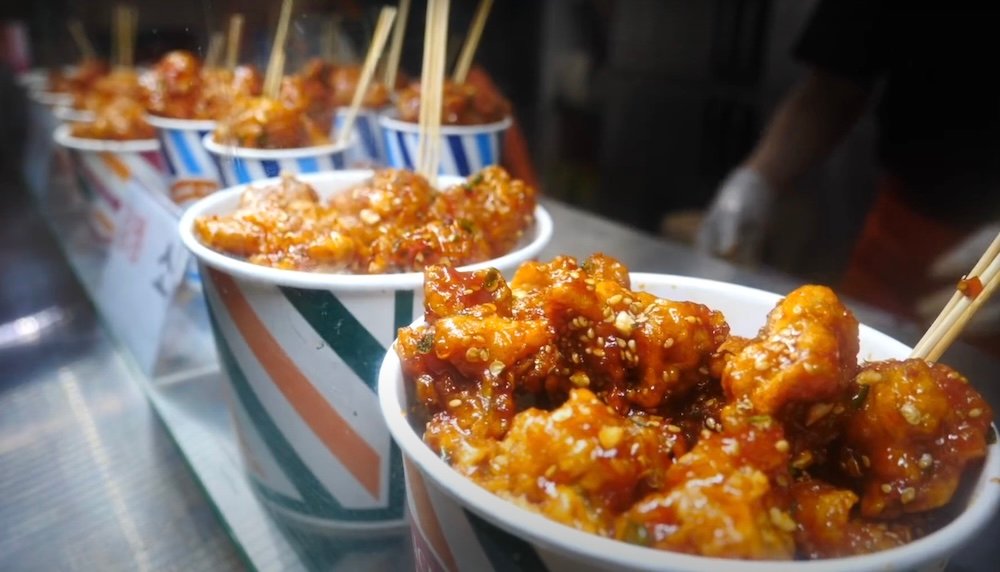
10. Chimaek (Chicken and Beer)
Chimaek, the beloved combination of fried chicken and beer, is a must-try when visiting Busan. The crispy, golden-brown fried chicken pairs perfectly with a cold glass of soju or beer, creating a deliciously satisfying meal. Whether you’re enjoying it at a bustling bar or a seaside restaurant, Chimaek offers a fun and social dining experience that’s perfect for unwinding after a day of exploration.
- Crispy Chicken: Savor the perfectly fried, flavorful chicken that’s a local favorite.
- Refreshing Beverages: Pair with soju, beer, or even craft cocktails for the best experience.
- Vibrant Atmosphere: Enjoy Chimaek in lively settings like Haeundae Beach or Seomyeon.

source: Samuel and Audrey on YouTube
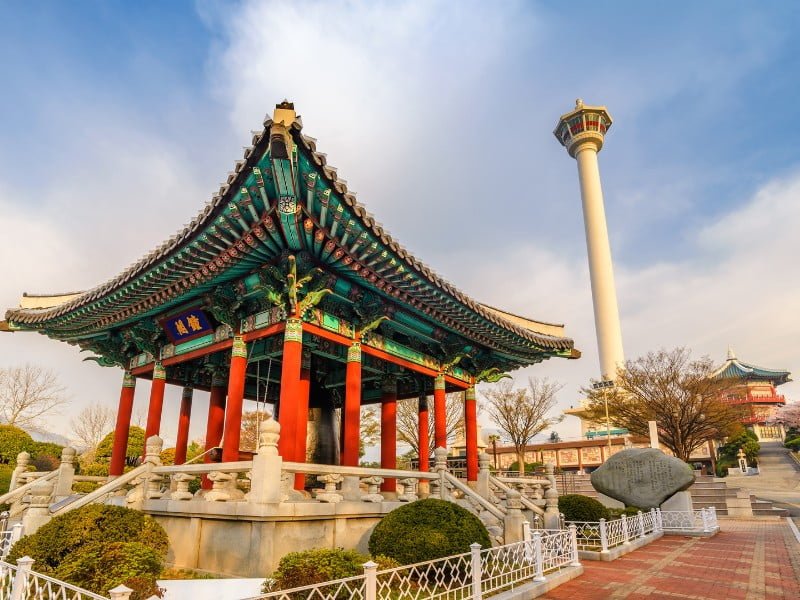
Tours For Visitors To Busan, South Korea
Here are some top tours that you can take to experience the best of Busan.
Let’s dive into some of the top tours that will make your Busan visit unforgettable.
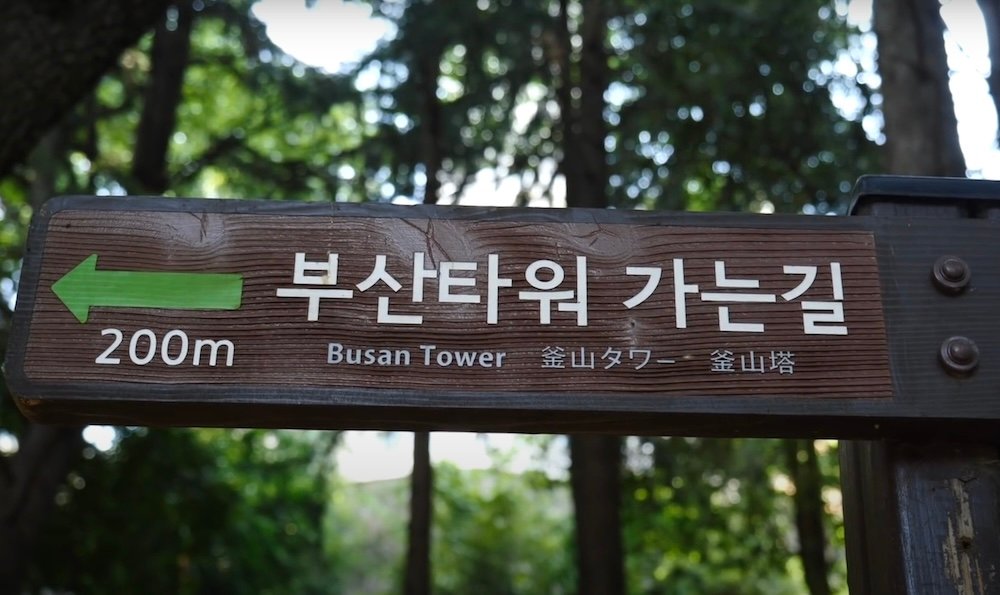
1. City Highlights Tour
Experience the best of Busan with the City Highlights Tour, a comprehensive journey through the city’s most iconic landmarks. This tour typically includes stops at Haeundae Beach, Gwangalli Beach, Busan Tower, and the Jagalchi Fish Market. Knowledgeable guides provide insightful commentary on the history and significance of each location, ensuring you gain a deeper appreciation of Busan’s culture and heritage.
- Comprehensive Itinerary: Covers major attractions like Haeundae and Gwangalli Beaches.
- Experienced Guides: Learn from knowledgeable locals who share fascinating stories.
- Flexible Options: Choose from half-day or full-day tours to fit your schedule.
2. Gamcheon Culture Village Walking Tour
Dive into the artistic heart of Busan with the Gamcheon Culture Village Walking Tour. Wander through the colorful, maze-like alleys adorned with vibrant murals and quirky art installations. The tour often includes visits to local cafes and shops, giving you a taste of the village’s unique charm and creative spirit. It’s perfect for photographers and art enthusiasts looking to capture Busan’s creative side.
- Artistic Exploration: Discover stunning murals and creative installations.
- Local Interaction: Meet artists and shop owners who bring the village to life.
- Photography Opportunities: Capture picturesque scenes in every corner of the village.
Nomadic Samuel and That Backpacker from Samuel and Audrey YouTube Channel
3. Busan Food Tour
Indulge your taste buds with the Busan Food Tour, a culinary adventure through the city’s best eateries and street food stalls. Sample a variety of local delicacies such as milmyeon, sundae, and ssiat hotteok while learning about their origins and significance. This tour typically includes visits to Jagalchi Fish Market and other renowned food districts, providing an authentic taste of Busan’s vibrant food scene.
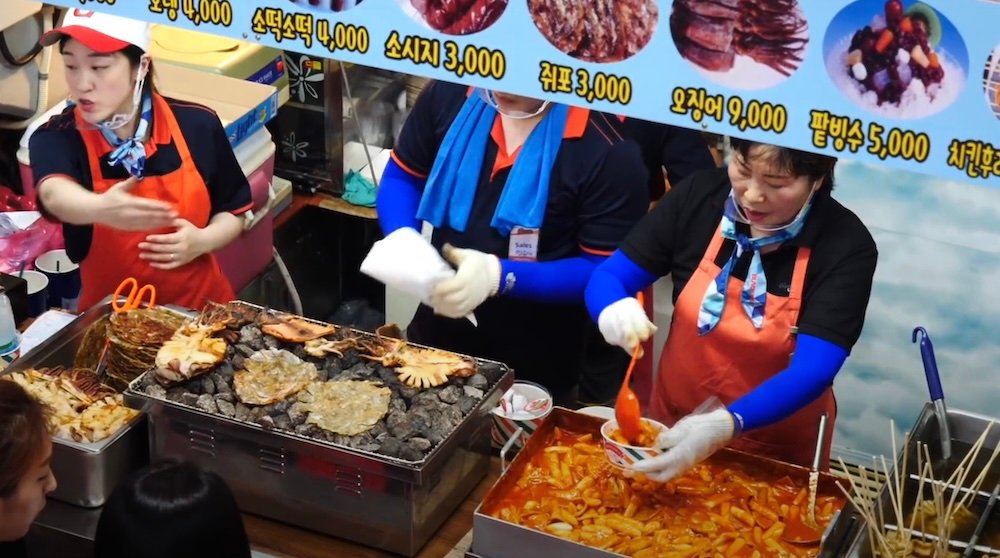
- Diverse Culinary Sampling: Try a wide range of traditional and modern dishes.
- Expert Guides: Learn about the history and preparation of each dish.
- Market Visits: Experience the bustling atmosphere of Busan’s top food markets.
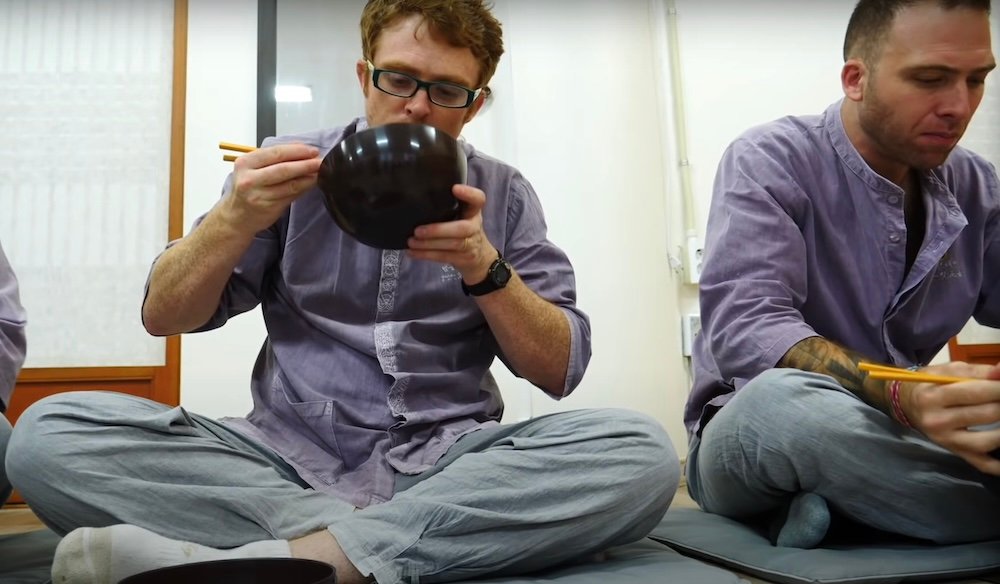
4. Temple Stay Experience
Immerse yourself in Korean spirituality with the Temple Stay Experience at Beomeosa Temple. Participate in meditation sessions, tea ceremonies, and Buddhist rituals led by monks. This tour offers a peaceful retreat from the city’s hustle and bustle, allowing you to connect with Busan’s serene side. It’s ideal for those seeking mindfulness and cultural enrichment during their travels.

- Spiritual Activities: Engage in meditation, tea ceremonies, and chanting.
- Cultural Insight: Gain a deeper understanding of Korean Buddhism and traditions.
- Tranquil Environment: Enjoy the peaceful surroundings of Beomeosa Temple.
5. Busan Harbor Cruise
See Busan from a different perspective with the Busan Harbor Cruise, offering stunning views of the city’s skyline and coastal landmarks. The cruise typically sails past Gwangan Bridge, Taejongdae, and Marine City, providing ample photo opportunities. Enjoy onboard amenities like refreshments and live entertainment, making it a relaxing and enjoyable way to spend your afternoon or evening.
- Scenic Views: Marvel at Busan’s impressive skyline and iconic bridges.
- Relaxing Atmosphere: Unwind with refreshments and live entertainment on board.
- Great for All Ages: Suitable for families, couples, and solo travelers alike.
6. Hiking and Nature Tours
For outdoor enthusiasts, Busan offers a variety of hiking and nature tours that explore the city’s lush landscapes and scenic trails. Popular routes include Geumjeongsan Mountain, Igidae Park, and Oryukdo Skywalk. These tours provide a mix of physical activity and natural beauty, perfect for those looking to escape the urban environment and enjoy Busan’s green spaces.
- Diverse Trails: Choose from easy walks to challenging hikes with rewarding views.
- Guided Expertise: Learn about the local flora, fauna, and geology from experienced guides.
- Breathtaking Scenery: Enjoy panoramic vistas, coastal paths, and tranquil forests.

7. Busan Night Tour
Experience the vibrant nightlife of Busan with the Busan Night Tour, which showcases the city’s illuminated landmarks and bustling evening spots. Highlights often include Gwangalli Beach, Busan Tower, and the Night Markets, where you can enjoy street performances and late-night snacks. This tour is perfect for those who want to see Busan come alive after dark and enjoy the city’s dynamic evening atmosphere.
- Illuminated Landmarks: See Busan’s iconic sites beautifully lit up at night.
- Night Markets: Explore lively markets offering food, souvenirs, and entertainment.
- Evening Entertainment: Enjoy live performances and vibrant street life.
8. Historical Busan Tour
Delve into Busan’s past with the Historical Busan Tour, which covers significant sites such as the UN Memorial Cemetery, Dongnae Eupseong Fortress, and Beomeosa Temple. This tour provides a comprehensive overview of the city’s role in Korean history, particularly during the Korean War. Guided by historians or knowledgeable locals, you’ll gain a deeper understanding of Busan’s resilience and cultural heritage.
- Significant Sites: Visit key historical landmarks that shaped Busan’s history.
- Educational Insights: Learn about Busan’s role in major historical events.
- Expert Guides: Benefit from detailed explanations and storytelling from history experts.
9. Art and Culture Tour
Explore Busan’s thriving arts scene with the Art and Culture Tour, which includes visits to the Busan Museum of Art, Huinnyeoul Culture Village, and the Trickeye Museum. This tour highlights the city’s commitment to contemporary art, traditional crafts, and innovative exhibitions. Perfect for art lovers, this experience offers a blend of gallery visits, workshops, and interactive installations.
- Museum Visits: Discover a variety of art styles and exhibitions at top museums.
- Creative Workshops: Participate in hands-on activities and learn from local artists.
- Cultural Insights: Gain an appreciation for Busan’s diverse artistic expressions.
10. Day Trip to Oryukdo Islands
Take a day trip to the Oryukdo Islands with a guided tour that includes the Oryukdo Skywalk, hiking trails, and photography spots. These small islets offer stunning natural landscapes and breathtaking sea views, perfect for nature lovers and photographers. The tour often includes a boat ride to the islands, providing a unique perspective of Busan’s coastal beauty.
- Skywalk Adventure: Experience walking on a glass-bottomed platform with panoramic views.
- Hiking Opportunities: Explore scenic trails with diverse natural scenery.
- Photography Heaven: Capture the dynamic beauty of the islands and ocean.
Busan Accommodations Guide: Hotels, Guesthouses and Hostels
Let’s explore some of the top options to help you choose the perfect spot for your Busan adventure.
1. Park Hyatt Busan
Experience unparalleled luxury at the Park Hyatt Busan, located in the heart of Haeundae. This five-star hotel boasts breathtaking views of the Haeundae Beach and the Busan Marina. With its elegant rooms, state-of-the-art amenities, and exceptional service, Park Hyatt is perfect for those seeking a premium stay. Enjoy fine dining at their renowned restaurants and unwind at the luxurious spa after a day of exploring the city.
- Stunning Views: Panoramic vistas of Haeundae Beach and Busan Marina.
- Luxury Amenities: Includes a world-class spa, fitness center, and rooftop pool.
- Fine Dining: Multiple gourmet restaurants offering a variety of cuisines.
2. Shilla Stay Haeundae
Located just steps away from Haeundae Beach, Shilla Stay Haeundae offers a blend of comfort and modern style. This mid-range hotel features spacious rooms with contemporary decor and all the essential amenities for a relaxing stay. The hotel’s convenient location makes it easy to explore nearby attractions like the Busan Aquarium and Centum City. Enjoy delicious meals at their on-site restaurant or grab a quick bite at the café.
- Prime Location: Close proximity to Haeundae Beach and major attractions.
- Modern Design: Stylish rooms equipped with all necessary comforts.
- Excellent Service: Friendly staff ensuring a pleasant and hassle-free stay.
3. Kimchee Busan Guesthouse
For travelers on a budget, Kimchee Busan Guesthouse in Gwangalli is an excellent choice. This friendly guesthouse offers both private rooms and dormitory-style accommodations, perfect for solo travelers or groups. The guesthouse features a communal kitchen, cozy lounge area, and free Wi-Fi, making it easy to relax and connect with other guests. Located near Gwangalli Beach, it’s ideal for those who want to enjoy the beach life without breaking the bank.
- Affordable Rates: Great value for both private and shared rooms.
- Social Atmosphere: Communal spaces encourage interaction with fellow travelers.
- Beach Access: Just a short walk to the beautiful Gwangalli Beach.
4. We Motel Premium Busan Station
Situated near Busan Station, We Motel Premium is a convenient option for travelers looking to stay in the city center. This budget-friendly motel offers clean and comfortable rooms with essential amenities like free Wi-Fi and air conditioning. Its central location makes it easy to access public transportation, shopping districts, and cultural sites. Whether you’re here for business or leisure, We Motel Premium provides a hassle-free stay at an affordable price.
- Central Location: Easy access to Busan’s main transportation hubs and attractions.
- Comfortable Rooms: Clean, cozy spaces equipped with modern conveniences.
- Budget-Friendly: Affordable pricing without compromising on quality.

5. Busan Guesthouse FEE
Nestled in the vibrant Seomyeon district, Busan Guesthouse FEE is a popular choice for backpackers and budget travelers. This charming guesthouse offers a variety of room types, from private rooms to shared dormitories, catering to different preferences and budgets. Guests can enjoy amenities like a shared kitchen, lounge area, and free breakfast. The guesthouse’s lively location means you’re never far from Busan’s best nightlife, shopping, and dining options.
- Flexible Accommodation: Options for both private and shared rooms.
- Great Amenities: Includes a shared kitchen, lounge, and complimentary breakfast.
- Lively Location: Close to Seomyeon’s bustling nightlife and shopping areas.
6. Hound Hotel
For those seeking a stylish and unique stay, Hound Hotel in Marine City is a top pick. This boutique hotel features sleek, modern design with an emphasis on comfort and luxury. Each room is thoughtfully designed with high-quality furnishings, ensuring a cozy and elegant atmosphere. Guests can enjoy amenities like a rooftop terrace, fitness center, and gourmet restaurant. The hotel’s prime location offers easy access to Marine City’s upscale shops and fine dining establishments.
- Boutique Luxury: Stylish, modern design with a focus on comfort.
- Premium Amenities: Rooftop terrace, fitness center, and gourmet dining options.
- Prime Location: Situated in Marine City, near upscale shopping and dining.
7. Busan Backpackers Hostel
Ideal for budget-conscious travelers and backpackers, Busan Backpackers Hostel in Nampo-dong offers a friendly and welcoming environment. This affordable hostel provides both dormitory-style rooms and private rooms, making it suitable for solo travelers or groups. The hostel features a communal kitchen, lounge area, and free Wi-Fi, fostering a social atmosphere where guests can share travel tips and stories. Its central location puts you within walking distance of key attractions like Gukje Market and the Busan Tower.
- Affordable Accommodation: Great prices for both dorms and private rooms.
- Social Environment: Communal areas encourage interaction among guests.
- Central Location: Easy access to Nampo-dong’s main attractions and markets.
8. Paradise Hotel Busan
Located in the heart of Seomyeon, Paradise Hotel Busan is a fantastic option for travelers seeking a blend of comfort and convenience. This mid-range hotel offers spacious rooms with modern amenities, including free Wi-Fi, air conditioning, and flat-screen TVs. Guests can enjoy on-site dining at their restaurant or relax at the hotel’s fitness center and spa. The hotel’s strategic location makes it easy to explore Busan’s vibrant shopping, dining, and entertainment scenes.
- Spacious Rooms: Comfortable and well-appointed rooms with modern amenities.
- On-Site Dining: Enjoy delicious meals at the hotel’s restaurant.
- Convenient Location: Situated in Seomyeon, near shopping, dining, and nightlife.
9. Goodstay Hostel Busan
For a modern and trendy hostel experience, Goodstay Hostel Busan in Gwangalli is a standout choice. This stylish hostel offers a variety of room types, including private rooms and shared dormitories, all designed with a contemporary aesthetic. Amenities include a communal kitchen, lounge area, and rooftop terrace with stunning views of Gwangalli Beach. The hostel’s prime location provides easy access to the beach, restaurants, and nightlife, making it perfect for both relaxation and adventure.
- Contemporary Design: Modern, stylish interiors that appeal to young travelers.
- Great Amenities: Includes a rooftop terrace, communal kitchen, and lounge area.
- Beachside Location: Close to Gwangalli Beach and vibrant local nightlife.
10. Lotte Hotel Busan
For those seeking the pinnacle of luxury, Lotte Hotel Busan offers an exceptional stay with top-notch amenities and impeccable service. Located in the prestigious Marine City, this five-star hotel features elegantly designed rooms with panoramic views of the ocean. Guests can indulge in fine dining at the hotel’s high-end restaurants, relax at the world-class spa, and enjoy exclusive access to private beach areas. The hotel’s luxurious atmosphere and prime location make it a favorite among discerning travelers.
- Ultimate Luxury: Five-star accommodations with elegant, spacious rooms.
- Fine Dining: Multiple gourmet restaurants offering a range of cuisines.
- Exclusive Amenities: World-class spa, private beach access, and premium services.
source: Samuel and Audrey on YouTube
Day Trips From Busan, South Korea
Here are some underrated day trips that deserve a spot on your Busan itinerary.
1. Geoje Island
Geoje Island, Korea’s second-largest island, is a paradise for nature lovers and adventure seekers alike. Just a short ferry ride from Busan, Geoje offers a mix of stunning landscapes, historical sites, and leisure activities that make for a perfect day trip.
- Oedo Botania: Wander through this exquisite botanical garden perched on a cliff, featuring beautiful floral displays, sculptures, and panoramic ocean views.
- Windy Hill: Capture the iconic photo of the windmill against the sea, a picturesque spot perfect for sunset views and relaxing walks.
- Haegeumgang Theme Park: Explore this theme park that offers mountain trails, beach access, and water sports, ideal for families and outdoor enthusiasts.
Geoje Island’s peaceful ambiance and natural beauty make it a refreshing contrast to Busan’s vibrant city life.
2. Tongdosa Temple
For a deep dive into Korea’s spiritual heritage, a visit to Tongdosa Temple is essential. Located about an hour from Busan, Tongdosa is one of the Three Jewel Temples of Korea and holds immense cultural and religious significance.
- Temple Grounds: Stroll through the serene temple complex, adorned with beautiful pagodas, statues, and traditional architecture.
- Buddhist Relics: Discover the treasures and relics that highlight the temple’s rich history and Buddhist traditions.
- Cultural Programs: Participate in temple stay programs that offer insights into Buddhist practices, meditation sessions, and traditional ceremonies.
Tongdosa Temple provides a tranquil retreat where you can connect with Korea’s spiritual roots and enjoy a peaceful environment.
3. Yangsan Jangsado Sea Park
Located in Yangsan, just a short drive from Busan, Jangsado Sea Park is a hidden coastal paradise that boasts stunning rock formations, flower gardens, and seaside trails. It’s an ideal destination for those seeking natural beauty and peaceful strolls.
- Flower Gardens: Enjoy the vibrant colors of seasonal flowers that bloom year-round, creating a picturesque landscape.
- Rock Formations: Marvel at the unique rock sculptures shaped by the ocean’s ebb and flow, perfect for photography enthusiasts.
- Walking Trails: Traverse the scenic walking paths that offer breathtaking views of the sea and surrounding nature.
Jangsado Sea Park is a quieter alternative to Busan’s main beaches, providing a serene escape amidst nature.
4. Ulsan Daewangam Park
A bit further afield but well worth the journey, Daewangam Park in Ulsan is a coastal haven known for its majestic cliffs, lush forests, and iconic rock formations. The park is perfect for a day of hiking, picnicking, and exploring nature.
- Daewangam Rock: Visit the famous rock formation that stands tall against the crashing waves, a symbol of Ulsan’s natural beauty.
- Hiking Trails: Embark on guided hikes through the park’s dense forests and along scenic coastal paths.
- Observatory Deck: Take in the panoramic views of the East Sea from the park’s observatory deck, offering stunning photo opportunities.
Daewangam Park’s dramatic landscapes and tranquil settings make it a perfect getaway for nature enthusiasts.
5. Gijang Haedong Yonggungsa Temple
While Haedong Yonggungsa Temple itself is a popular attraction within Busan, exploring the surrounding Gijang County unveils several underrated sites that enhance your day trip experience.
- Songjeong Beach: Relax on the quiet shores of Songjeong Beach, ideal for surfing, swimming, and sunbathing away from the crowds.
- Dadaepo Beach: Explore Dadaepo Beach, famous for its beautiful sunsets, wide sandy shores, and lush wetlands.
- Geumjeongsan Mountain: Hike the trails of Geumjeongsan Mountain, offering stunning vistas, historic fortresses, and peaceful temples.
Gijang County combines natural wonders with cultural landmarks, providing a well-rounded and enriching day trip from Busan.
6. Upo Wetland
For a completely different experience, venture to the Upo Wetland in Changnyeong, about two hours from Busan. As Korea’s largest inland wetland, Upo offers a unique ecosystem teeming with wildlife, lush vegetation, and tranquil waterways.
- Walking Trails: Traverse the network of trails that wind through the wetland, perfect for bird watching and nature photography.
- Boat Rides: Take a boat tour to explore the wetlands from the water, offering a different perspective of the area’s natural beauty.
- Visitor Center: Learn about the wetland’s ecological importance and conservation efforts at the informative visitor center.

Busan Transportation Guide
Whether you prefer the efficiency of public transit, the convenience of taxis, or the freedom of renting a bike, Busan has options to suit every traveler’s needs. Here’s your comprehensive guide to navigating this vibrant coastal city with ease.
1. Public Transportation
Busan boasts an extensive public transportation network that’s both affordable and reliable, making it the go-to choice for many visitors.
Busan Metro
The Busan Metro is the backbone of the city’s public transit, consisting of five lines that cover most of Busan and its surrounding areas.
- Efficiency: Trains run frequently, typically every 5-10 minutes during peak hours.
- Coverage: Connects major districts like Haeundae, Seomyeon, and Nampo-dong.
- Ease of Use: Clear signage in both Korean and English makes navigation simple.
- Tickets: Purchase single-journey tickets or use a T-money card for seamless transfers.
City Buses
Complementing the metro, Busan’s city buses reach areas not covered by the subway, including scenic spots and residential neighborhoods.
- Variety: Includes local, express, and airport buses.
- Cost-Effective: Fares are inexpensive, especially when using a T-money card.
- Real-Time Information: Many buses provide real-time tracking through apps.
T-Money Card
A T-money card is your key to effortless travel across all public transportation modes in Busan.
- Convenience: Reloadable and can be used on buses, subways, and even some taxis.
- Discounts: Offers fare discounts and eliminates the need to buy individual tickets.
- Availability: Easily purchased and recharged at metro stations, convenience stores, and kiosks.

2. Taxis
For those times when public transit isn’t the best option, taxis in Busan are plentiful and relatively affordable.
Types of Taxis
- Standard Taxis: Black or orange in color, suitable for most rides.
- Deluxe Taxis (Jongseok Taxis): More spacious and comfortable, often yellow or white.
- International Taxis: Equipped with English-speaking drivers, ideal for non-Korean speakers.
How to Use Taxis
- Hailing a Taxi: Simply flag one down on the street or use a taxi stand.
- Apps: Utilize ride-hailing apps like Kakao Taxi for added convenience.
- Fares: Base fare starts around KRW 3,800, with additional charges per kilometer.
Tips for Riding Taxis
- Have Your Destination Ready: Write down your address in Korean to show the driver.
- Avoid Rush Hours: Traffic can be heavy during peak times, so plan accordingly.
- Payment Options: Most taxis accept cash and some accept credit cards or T-money cards.
3. Rental Cars
Exploring Busan and its surrounding areas by rental car offers unmatched flexibility, especially for those looking to visit more remote attractions.
Rental Car Services
- Major Providers: Companies like Hertz, Avis, and Lotte Rent-a-Car operate in Busan.
- Locations: Available at the airport, major hotels, and city centers.
Driving in Busan
- Traffic: Busan has a well-maintained road network, but be mindful of traffic during rush hours.
- Navigation: Use GPS or map apps to navigate the city efficiently.
- Parking: Many hotels offer parking, and there are public parking lots throughout the city.
Requirements
- International Driving Permit (IDP): Required for foreign visitors driving in Korea.
- Age: Drivers must typically be at least 21 years old with a valid license.
4. Bicycles and Electric Scooters
For a more eco-friendly and active way to explore Busan, consider renting a bicycle or electric scooter.
Bicycle Rentals
- Sea Life Cycle: Available at popular beaches like Haeundae and Gwangalli.
- Bike Paths: Enjoy scenic rides along the Busan Coastal Trail and Taejongdae.
Electric Scooters
- Convenience: Perfect for short distances and navigating through busy streets.
- Rental Apps: Use services like Share The Ride or Kakao T to rent scooters easily.
Safety Tips
- Wear Helmets: Always prioritize safety by wearing a helmet.
- Follow Traffic Rules: Adhere to local traffic regulations and signals.
- Be Mindful of Pedestrians: Especially in crowded areas and parks.
5. Ferries and Boats
Busan’s coastal location makes ferries and boats a charming way to travel and explore nearby islands.
Main Ferry Routes
- Geoje Island: Frequent ferries connect Busan to Geoje, offering stunning sea views.
- Oryukdo Island: Take a boat tour to the famous Oryukdo Skywalk and enjoy the scenic coastline.
Boat Tours
- Harbor Cruises: Enjoy a leisurely cruise around Busan Harbor, perfect for sunset views.
- Theme Boats: Choose from fishing boats, sightseeing boats, and luxury yachts for a personalized experience.
Tickets and Schedules
- Booking: Purchase tickets online or at ferry terminals.
- Schedules: Check ferry timetables in advance, as services may vary by season.
6. Walking and Exploring
Busan is a highly walkable city, with many areas easily navigable on foot.
Popular Walking Areas
- Haeundae Beach: Stroll along the sandy shores and enjoy the vibrant beachfront.
- Gwangalli Beach: Walk across the bridge for incredible night views.
- Gamcheon Culture Village: Explore the colorful alleys and artistic installations on foot.
Tips for Walking in Busan
- Comfortable Shoes: Wear comfortable footwear to navigate the city’s diverse terrains.
- Stay Hydrated: Especially important during the warmer months.
- Plan Your Route: Use maps or apps to plan your walking itinerary and make the most of your time.

7. Tips for Getting Around Busan
Maximize your Busan experience with these handy transportation tips:
- Use a T-money Card: Simplifies payments across all public transport modes.
- Learn Basic Korean Phrases: Helpful when navigating public transport or hailing taxis.
- Check Schedules: Always verify public transport schedules to avoid long waits.
- Stay Connected: Rent a portable Wi-Fi or use a SIM card for easy access to maps and transport apps.
- Plan Ahead: Especially for popular attractions, booking tickets or tours in advance can save time.

Where To Visit After Your Trip To Busan?
Here are some must-visit places to consider after Busan.
source: Nomadic Samuel and That Backpacker on Samuel and Audrey YouTube channel
1. Seoul: The Dynamic Capital
No trip to South Korea is complete without experiencing Seoul, the country’s vibrant capital. A bustling metropolis where tradition meets modernity, Seoul offers an endless array of activities and sights.
- Historical Palaces: Explore the grand Gyeongbokgung Palace and the serene Changdeokgung Palace, each showcasing stunning architecture and rich history.
- Shopping Districts: Dive into the lively streets of Myeongdong and Dongdaemun, perfect for fashionistas and food lovers alike.
- Cultural Experiences: Visit the Bukchon Hanok Village to see traditional Korean houses and enjoy cultural performances in areas like Insadong.
Seoul’s dynamic energy and diverse attractions make it the perfect follow-up to your Busan adventure.
2. Gyeongju: The Museum Without Walls
Step back in time with a visit to Gyeongju, often referred to as Korea’s ancient capital. This city is a treasure trove of historical sites and cultural heritage.
- Bulguksa Temple: Marvel at this UNESCO World Heritage site, renowned for its intricate architecture and serene surroundings.
- Seokguram Grotto: Discover the stunning Buddha statue nestled within this ancient cave temple, offering breathtaking views.
- Anapji Pond: Stroll around this picturesque pond, beautifully illuminated at night and perfect for leisurely walks.
Gyeongju’s rich history and well-preserved landmarks provide a deep dive into Korea’s past.
3. Jeju Island: Nature’s Paradise
For those seeking natural beauty and relaxation, Jeju Island is a dream come true. Known for its volcanic landscapes, waterfalls, and beaches, Jeju offers a serene escape from the city hustle.
- Hallasan Mountain: Hike Korea’s highest peak, surrounded by lush forests and panoramic views from the summit.
- Seongsan Ilchulbong (Sunrise Peak): Witness stunning sunrises from this volcanic crater, a favorite spot for photographers.
- Jeju Loveland: Explore this unique outdoor sculpture park, celebrating art and romance in a playful setting.
Jeju Island’s diverse attractions and scenic beauty make it a perfect getaway after Busan.
4. Andong: The Heart of Korean Tradition
Immerse yourself in traditional Korean culture with a trip to Andong, a city famed for its heritage and folklore.
- Hahoe Folk Village: Wander through this well-preserved village, home to traditional hanok houses and the vibrant Mask Dance Festival.
- Andong Soju Museum: Learn about the history and production of Andong Soju, Korea’s beloved traditional liquor.
- Woryeonggyo Bridge: Enjoy a peaceful stroll across this historic bridge, offering beautiful views of the surrounding landscape.
Andong’s authentic cultural experiences offer a meaningful contrast to Busan’s modern vibrancy.
5. DMZ Tour: A Glimpse Into Korea’s Divide
For a unique and thought-provoking experience, consider a tour to the Demilitarized Zone (DMZ). This area offers a rare insight into the complex history and current tensions between North and South Korea.
- Panmunjom (Joint Security Area): Stand on the border line and see firsthand the division between the two Koreas.
- Third Infiltration Tunnel: Explore this tunnel dug by North Korea, intended for military invasion, and learn about its discovery.
- Dorasan Station: Visit the last train station before the border, symbolizing hope for future reunification.
A DMZ tour provides a powerful perspective on Korea’s ongoing story, making it a compelling addition to your itinerary.
6. Incheon: Modern Marvels and Cultural Sites
Just a short trip from Seoul, Incheon is a dynamic city known for its modern infrastructure and cultural attractions.
- Songdo International Business District: Explore this futuristic area with its impressive skyline, parks, and eco-friendly designs.
- Chinatown: Experience the vibrant flavors and unique architecture of Korea’s largest Chinatown, offering delicious food and cultural performances.
- Incheon Landing Operation Memorial Hall: Learn about the historic Incheon Landing during the Korean War through interactive exhibits and artifacts.
Incheon’s blend of modernity and history makes it a fascinating destination to explore after Busan.
7. Daegu: The Fashion and Culture Hub
Discover Daegu, a city renowned for its fashion industry, cultural festivals, and beautiful temples.
- Apsan Park: Hike through this expansive park, offering stunning views of Daegu and lush green trails.
- Donghwasa Temple: Visit this serene temple known for its majestic Buddha statue and tranquil surroundings.
- Seomun Market: Dive into the local scene at one of Korea’s oldest markets, perfect for shopping and tasting traditional street food.
Daegu’s unique blend of fashion, culture, and natural beauty provides a well-rounded experience for travelers.

Busan Travel FAQ: Practical Tips, Beaches, Itineraries, Food & Day Trips
1. How many days do I really need in Busan?
Three.
With three full days you can hit the headline spots like Haeundae, Gwangalli, Gamcheon Culture Village, Beomeosa Temple, a market or two, plus one viewpoint such as Hwangnyeongsan or Oryukdo. If you want to add day trips (Geoje Island, Tongdosa, Daewangam Park) or slow down for cafes, jjimjilbangs, and baseball games, think 4–5 nights. Busan is a city that rewards an extra day.
2. When is the best time of year to visit Busan?
Spring and autumn are the sweet spots.
From April–June and September–early November you’ll get comfortable temperatures, good hiking conditions on Geumjeongsan or Jangsan, and beach walks without the worst humidity. July–August is peak beach season (and peak crowds) at Haeundae and Gwangalli, while winter is quieter but still very visitable thanks to Busan’s milder coastal climate.
3. Where’s the best area to stay in Busan for first-time visitors?
If it’s your first trip, base yourself in Haeundae or Gwangalli.
Haeundae is classic “Busan by the sea” with a big sandy beach, nightlife, the aquarium, and easy access to Centum City and BIFF. Gwangalli feels more local and relaxed with amazing views of Gwangan Bridge at night. Seomyeon is great if you want a busy, central neighbourhood with food and shopping, while Nampo-dong puts you near Jagalchi Fish Market, Gukje Market, and Busan Tower.
4. Is Busan easy to explore without speaking Korean?
Yes.
Busan is very doable with just English and a few basic Korean phrases. The metro has clear signage in English, announcements are bilingual, and many restaurants in touristy areas have photo menus. Having your hotel name and key places written in Korean on your phone helps with taxis. A translation app fills in the gaps when you’re ordering in markets or chatting with street-food vendors.
5. How do I get from Seoul to Busan, and which option is best?
For most travelers, the KTX high-speed train is king.
The KTX zips between Seoul and Busan in about 2.5–3 hours, drops you centrally at Busan Station, and is comfortable and simple to use. Slower trains are cheaper but take much longer, and intercity buses can work if you’re already outside Seoul. Flights only make sense if you’re connecting onward internationally, not just hopping down from the capital.
6. Do I really need a T-money card in Busan?
You don’t need it, but you’ll be happier if you have one.
A T-money (or compatible) transit card lets you tap on and off the metro and buses without buying single tickets every time, and you usually get a slight discount on fares. You can pick one up and reload it at convenience stores and metro stations. It also works in other Korean cities, so it’s handy if you’re pairing Busan with Seoul, Daegu, or beyond.
7. Is Busan expensive, and what daily budget should I plan for?
Busan is generally cheaper and more relaxed on the wallet than Seoul.
On a backpacker budget, you can get by on roughly 50–70 USD per day with hostel beds, street food, markets, public transport, and the occasional attraction fee. Mid-range travelers who like cafes, a few nicer meals, and comfortable hotels can plan around 100–150 USD per day. Add more if you’re leaning into luxury stays like Park Hyatt Busan or Lotte Hotel and doing multiple tours or harbor cruises.
8. Which Busan beach should I choose: Haeundae, Gwangalli, Songdo, or Songjeong?
Each one has a different personality.
- Haeundae Beach: Big, busy, classic resort vibe with festivals, bars, and lots of energy.
- Gwangalli Beach: Medium-sized, chill, perfect for views of Gwangan Bridge and evening drinks.
- Songdo Beach: Great if you want cable cars, skywalks, and a bit less chaos than Haeundae.
- Songjeong Beach: Laid-back surf beach, ideal for lessons, families, and a slower pace.
If you’re short on time, pair Haeundae by day with Gwangalli at night.
9. What foods are absolutely unmissable in Busan?
Come hungry.
Busan is all about the sea and street snacks: milmyeon (cold wheat noodles), eomuk (fish cakes on skewers in hot broth), ssiat hotteok (seed-stuffed pancakes), Dongnae pajeon, raw fish (hoe) at Jagalchi, hearty gukbap, and of course chimaek (fried chicken and beer). Hit places like Jagalchi Fish Market, Gukje Market, Bupyeong Kkangtong Market, Haeundae Market, and random pojangmacha (tents) and you’ll eat very well.
10. Is Busan safe for solo travelers, including at night?
Overall, yes – Busan feels very safe by global big-city standards.
You’ll still want normal street smarts: keep an eye on your belongings in busy markets, avoid extremely drunk crowds late at night, and stick to well-lit streets when walking home. Solo female travelers will find Haeundae, Seomyeon, and Nampo-dong perfectly fine if you’re sensible. Public transport and taxis are safe and widely used by locals.
11. What are the best day trips from Busan?
You’re spoiled for choice.
From Busan you can easily head to Geoje Island (Oedo Botania, Windy Hill), Tongdosa Temple, Yangsan Jangsado Sea Park, Ulsan’s Daewangam Park, Gijang County around Haedong Yonggungsa, or further out to Upo Wetland. Some trips are smoother with a tour (Geoje + Oedo Botania is a classic), while temples and parks are doable independently if you’re comfortable with buses or renting a car.
12. Do I need to book tours and temple stays in advance?
For popular experiences, booking ahead is smart.
City highlights tours, food tours, harbor cruises, and temple stays at Beomeosa can fill up during weekends, holidays, and festival periods like the Busan International Film Festival. If you’re traveling in peak season or your time is tight, reserve in advance so you’re not scrambling on the day. For things like markets, beaches, and parks, you can just show up.
13. How should I split my time between Busan, Seoul, and other Korean cities?
Think in “blocks” of 3–4 days.
A classic first-timer route might be 4–5 days in Seoul, 3–4 in Busan, and 1–2 in Gyeongju or Jeju if you have extra time. If you’re more of a beach and food person than a palace and museum person, lean heavier towards Busan and nearby coastal day trips (Geoje, Tongdosa, Gijang). The KTX connection makes it easy to move between cities without burning an entire day.
14. What’s a simple 3-day Busan itinerary for first-timers?
Here’s an easy starter plan:
- Day 1 – City + Markets: Yongdusan Park & Busan Tower, Jagalchi Fish Market, Gukje Market, Nampo-dong streets, evening views at Gwangalli Beach and Gwangan Bridge.
- Day 2 – Beaches + Temples: Haeundae Beach, Sea Life Busan Aquarium, Dongbaekseom & Nurimaru APEC House, sunset at Cheongsapo Daritdol Observatory or Oryukdo Skywalk, chimaek to finish.
- Day 3 – Culture + Views: Gamcheon Culture Village, Beomeosa Temple and/or Geumjeongsan hiking, Busan Museum or Museum of Art, night views from Hwangnyeongsan or a Busan Night Tour.
From there you can plug in extra beaches, spas, baseball, or day trips as time allows.
15. Is Busan a good choice for families and kids?
Absolutely.
Kids tend to love the beach time at Haeundae and Songdo, the Sea Life Busan Aquarium, cable cars and skywalks, playground-style parks, and the sheer novelty of Korean street food. Many attractions are stroller-friendly, public transport is straightforward, and there are plenty of family-friendly guesthouses and hotels near the main beaches. Just keep summer heat, crowds, and nap times in mind when you plan your days.
Busan Travel Guide: Final Thoughts
From the sun-kissed beaches and bustling markets to the tranquil temples and modern skyscrapers, Busan is a city of endless surprises and unforgettable moments.

Embrace the Diversity
Busan is a city that beautifully blends the old with the new, the natural with the urban, and the traditional with the contemporary. Each neighborhood offers a unique vibe, making every corner worth exploring.
- Cultural Riches: Dive into the city’s heritage by visiting historical sites like Beomeosa Temple and Dongnae Eupseong Fortress.
- Modern Marvels: Experience the sleek design and bustling energy of Centum City and the iconic Busan Cinema Center.
- Natural Beauty: Don’t miss the serene landscapes of Taejongdae Resort Park and the picturesque Gamcheon Culture Village.

Savor Every Bite
Busan’s culinary scene is a delight for food enthusiasts. From fresh seafood at Jagalchi Fish Market to mouthwatering street food in Gukje Market, the city offers a vast array of flavors that cater to all tastes.
- Local Specialties: Make sure to try milmyeon, sundae, and ssiat hotteok for an authentic taste of Busan.
- Fine Dining: Treat yourself to a meal at top-notch restaurants like Park Hyatt Busan or The Bay 101 Seafood Buffet for a luxurious culinary experience.
- Casual Eats: Enjoy casual dining at Kimchee Busan Guesthouse or Busan Backpackers Hostel, where you can mingle with fellow travelers over delicious meals.

Navigate with Ease
Busan’s efficient transportation system makes getting around the city straightforward and stress-free. Whether you’re hopping on the Busan Metro, taking a taxi, or renting a bike, you’ll find plenty of options to suit your travel style.
- Public Transit: Utilize the Busan Metro and city buses for affordable and convenient travel across the city.
- T-Money Card: Invest in a T-money card for seamless access to all public transportation modes.
- Flexible Options: Consider renting a car or using bike rentals for exploring areas beyond the city center.

Capture the Memories
Busan is a photographer’s paradise, with every spot offering something visually stunning. From the sunsets at Gwangalli Beach to the colorful streets of Gamcheon Culture Village, your camera will be busy capturing the city’s beauty.
- Scenic Views: Don’t forget to visit the Gwangan Bridge at night for breathtaking illuminated views.
- Artistic Corners: Explore the Trickeye Museum and Huinnyeoul Culture Village for creative and interactive photo opportunities.
- Natural Landscapes: Capture the serene beauty of Jangsan Mountain and the Oryukdo Skywalk.
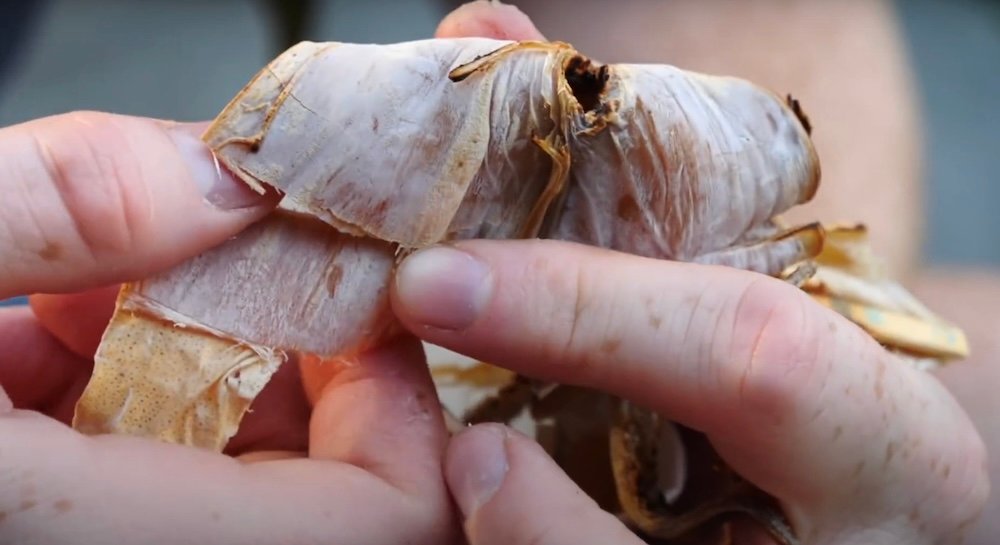
Plan for the Future
While Busan offers a wealth of experiences, South Korea has so much more to explore. Use the inspiration from your Busan trip to plan future adventures to other incredible destinations like Seoul, Jeju Island, and Gyeongju.
- Extended Trips: Consider multi-city itineraries to experience the full breadth of Korea’s culture and landscapes.
- Seasonal Visits: Each season in Busan offers something unique, from spring blossoms to winter festivals. Plan your visit accordingly to enjoy the best the city has to offer.
- Local Insights: Engage with locals and fellow travelers to discover hidden gems and insider tips for your next trip.

Final Advice
- Stay Curious: Don’t be afraid to explore off the beaten path. Some of the best experiences in Busan come from spontaneous adventures and unexpected discoveries.
- Be Respectful: Embrace and respect the local culture and traditions. Simple gestures like learning basic Korean phrases or following local customs can enhance your interactions.
- Relax and Enjoy: While it’s tempting to pack your schedule, make sure to take time to relax and soak in the atmosphere. Busan’s laid-back beaches and peaceful parks are perfect for unwinding.
Until next time, adventurous travels!

Ode To Busan
Busan, city of the sea and light, A place where beauty blends with might, Where modern meets tradition old, And stories of the past are told.
Gamcheon Village, colors bright, A winding maze, a stunning sight, Art and culture, mixed in style, A place to wander and beguile.
Jagalchi Market, seafood fresh, A lively hub, a bustling mesh, The catch of the day on offer wide, A feast for all, a foodie’s pride.
Nature’s splendor, Haeundae Beach, Soft sands, clear waters within reach, A place to rest, a place to play, A haven in the heat of day.
Transportation, easy and smooth, Subway, taxi, bus to move, To explore Busan’s neighboring lands, And make the most of travel plans.
Accommodations, diverse and grand, From luxury hotels to hostels stand, A place to rest, a place to dream, A place to call home, it seems.
Busan, a city with a heart, Where memories and stories start, A place to explore, a place to find, A treasure for travelers, one of a kind.
